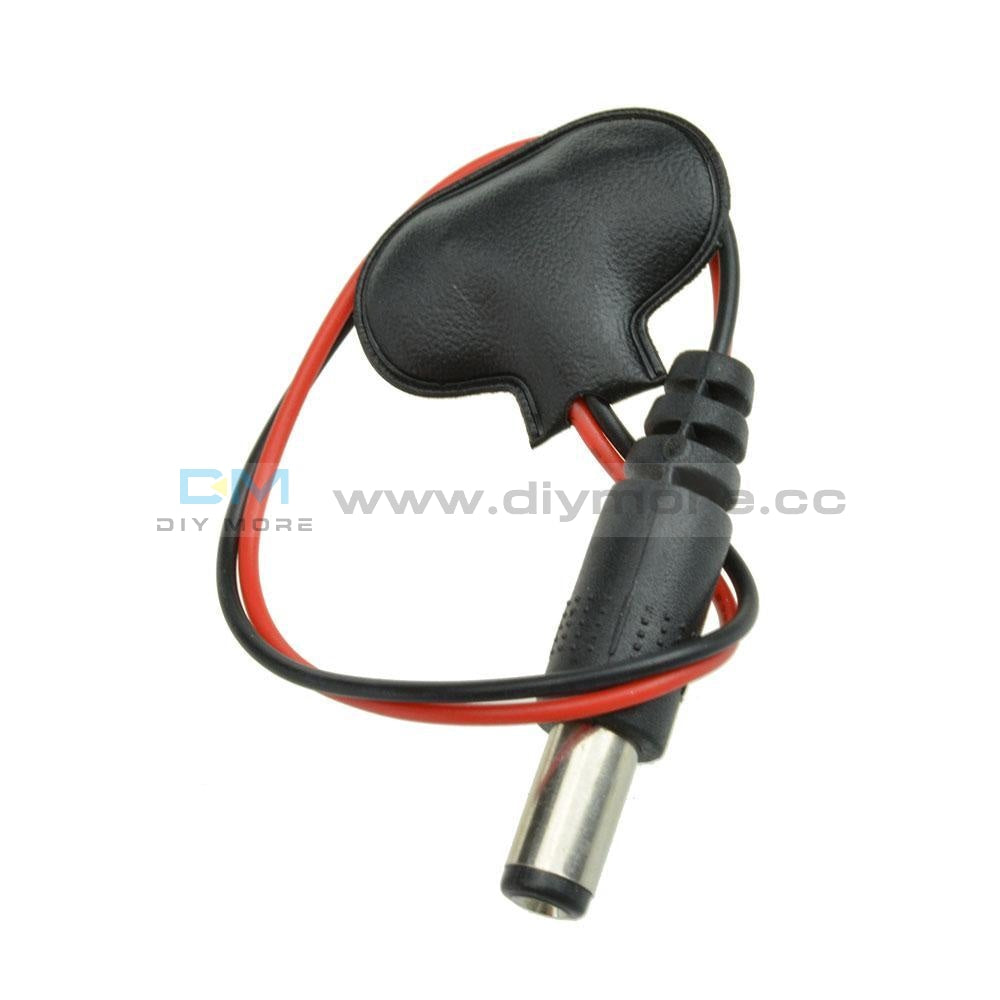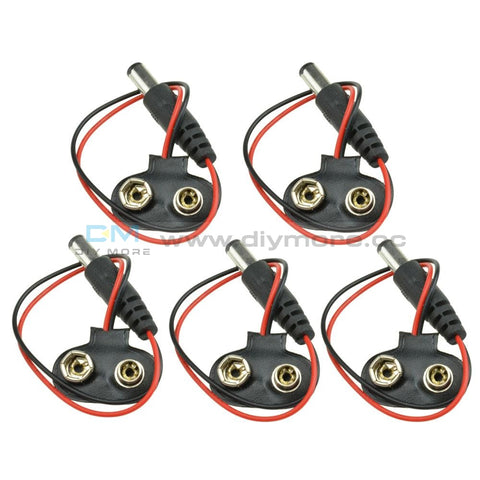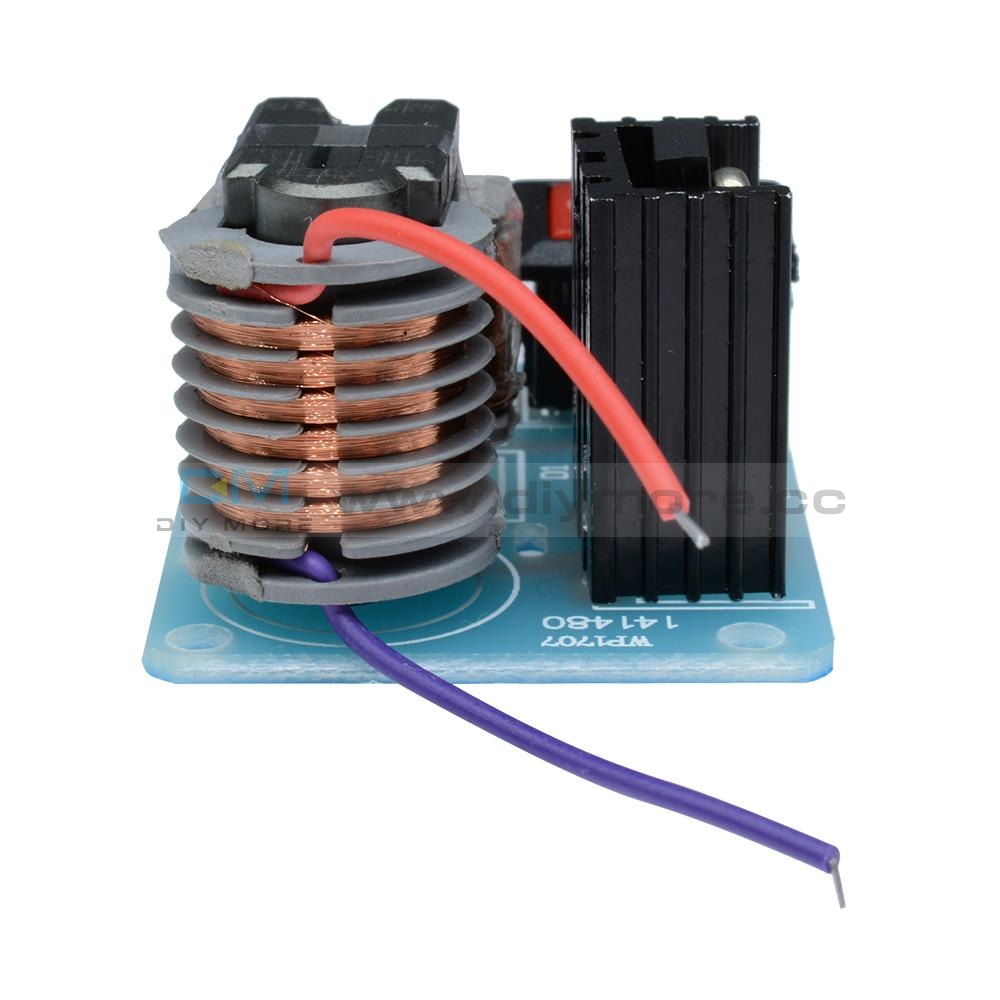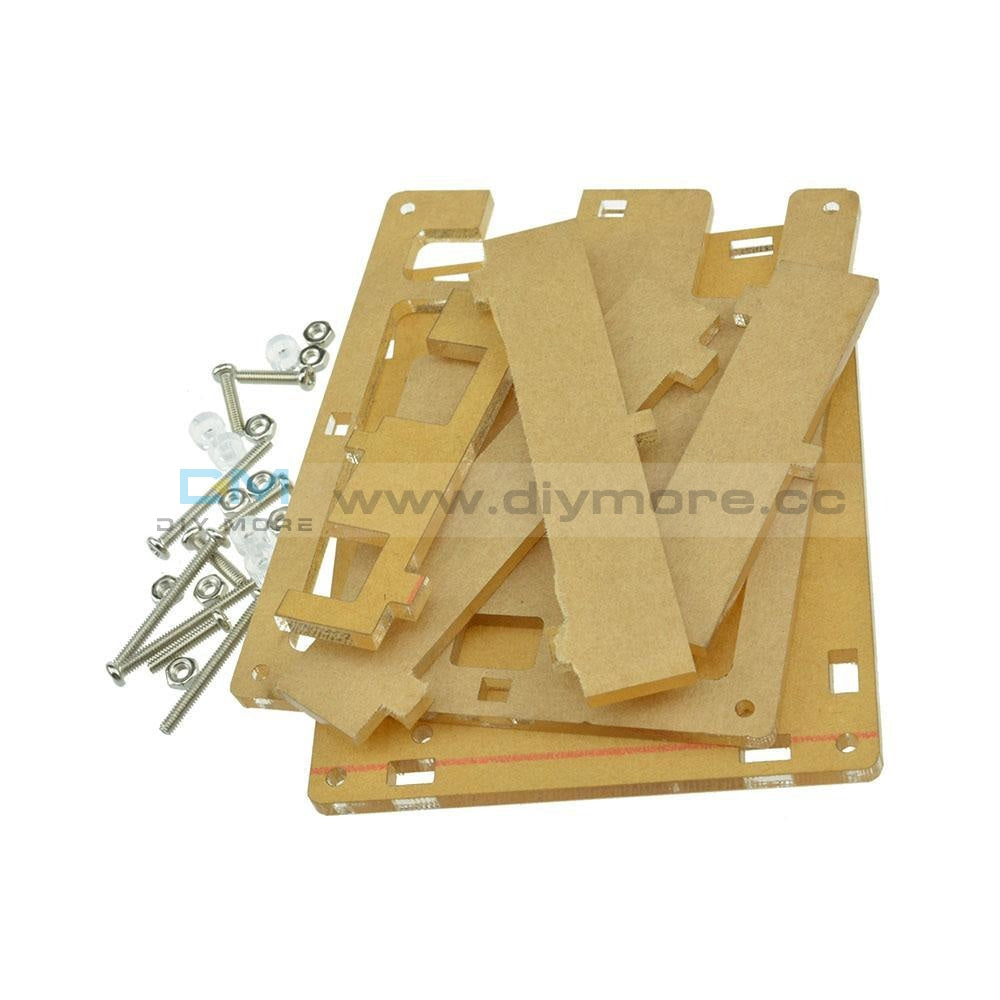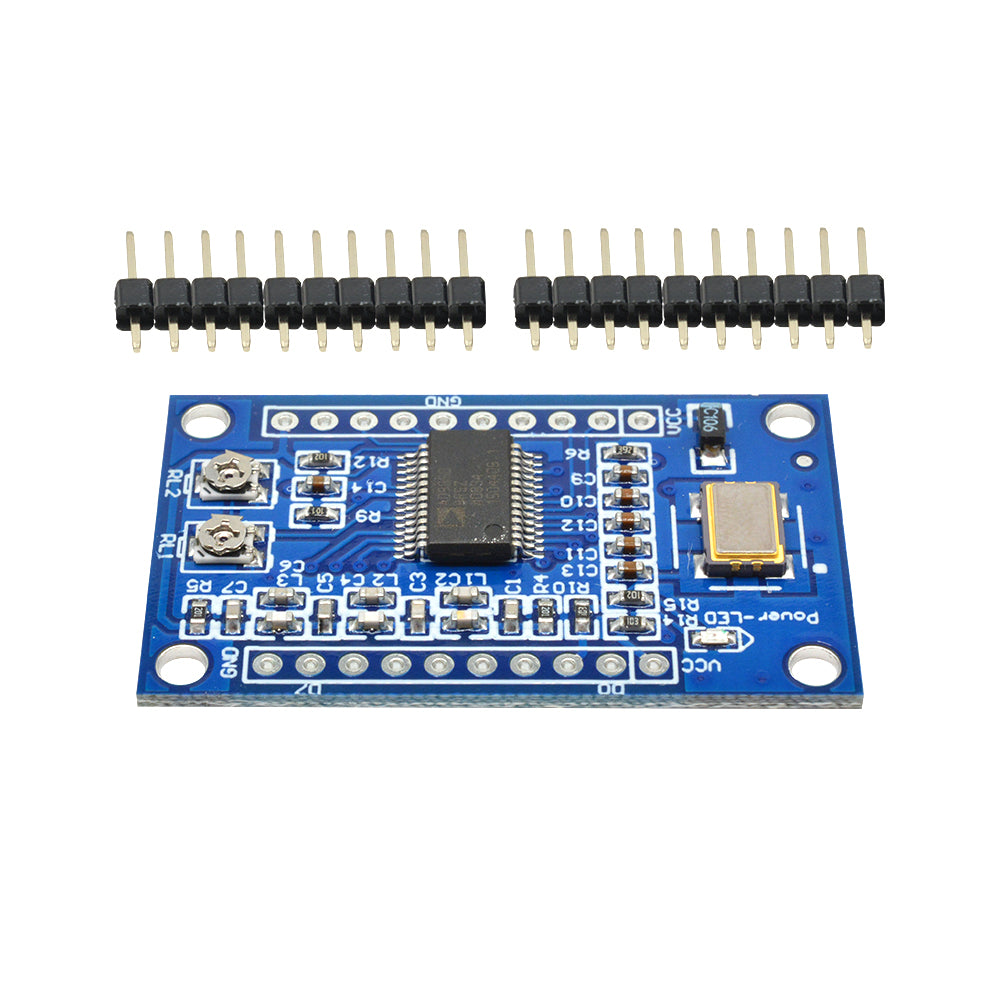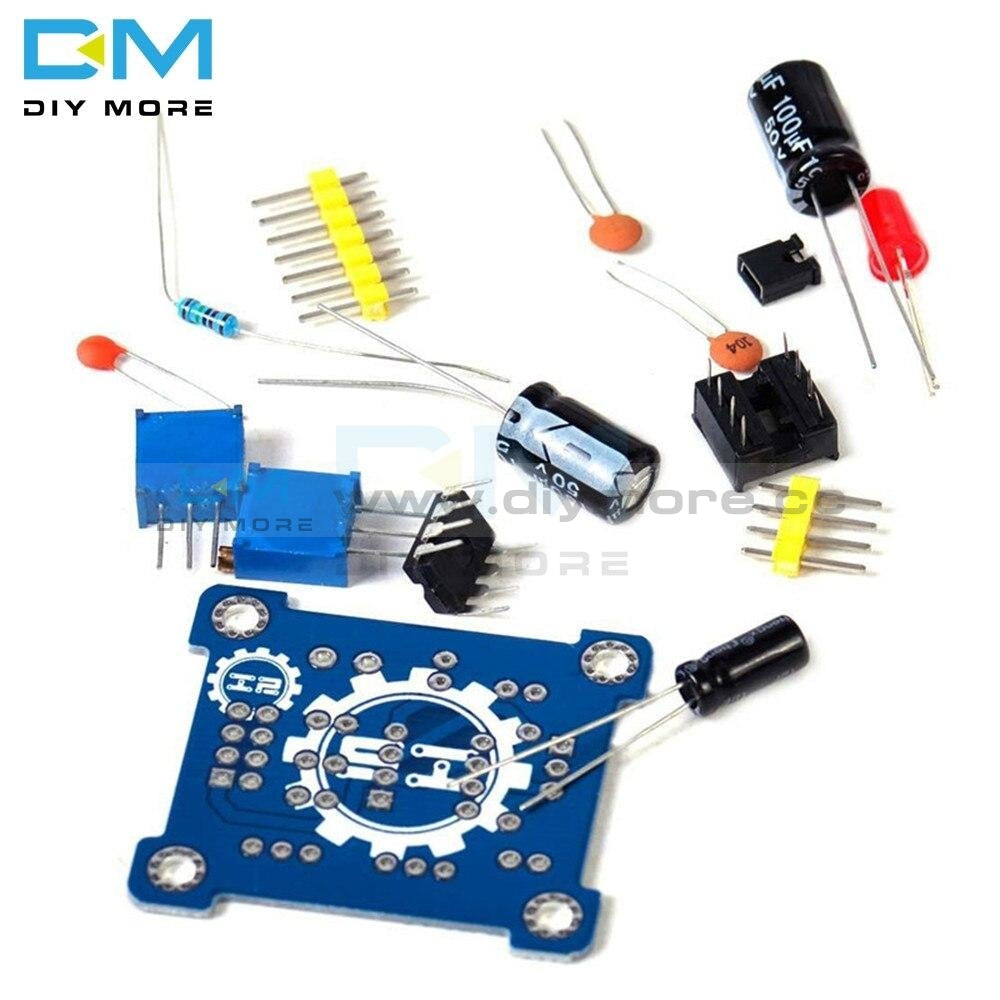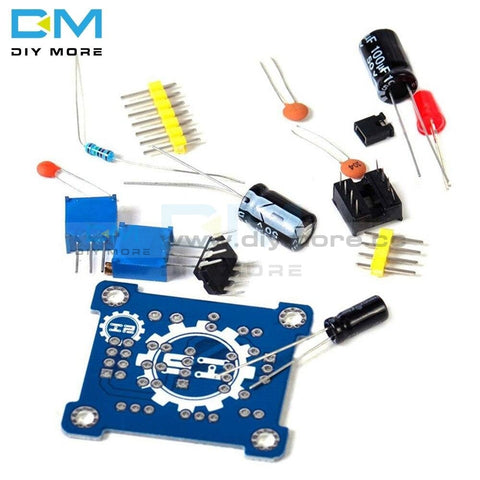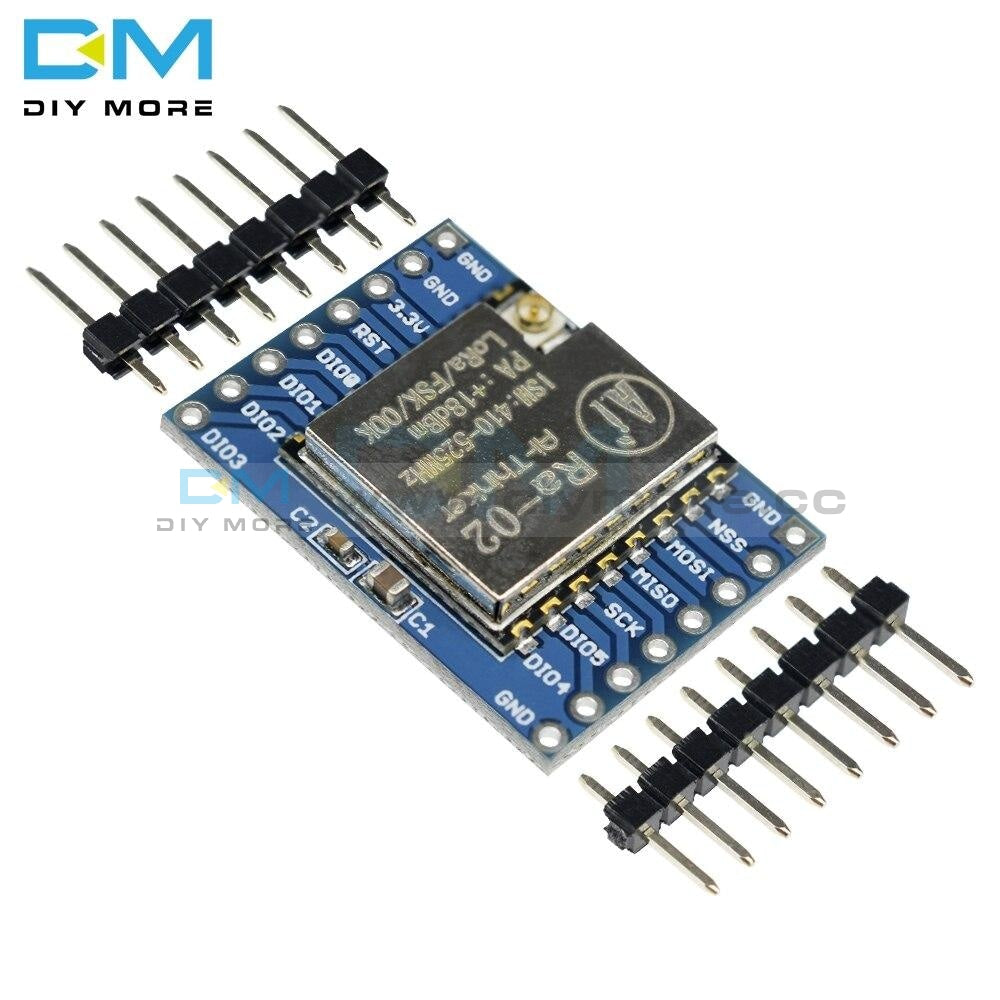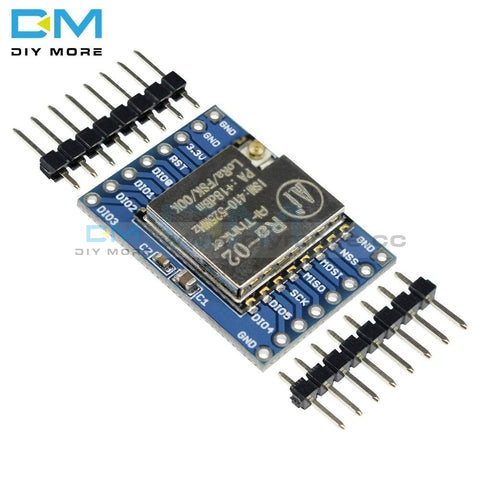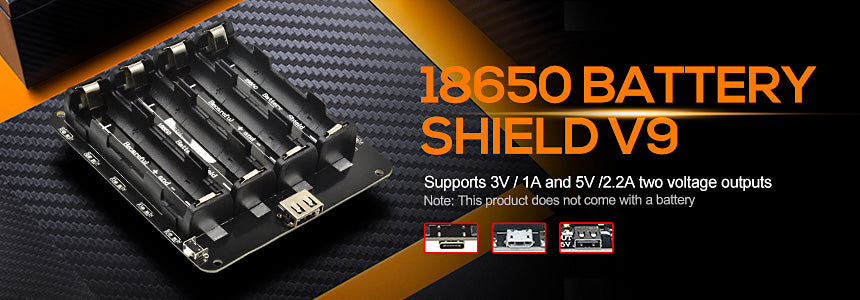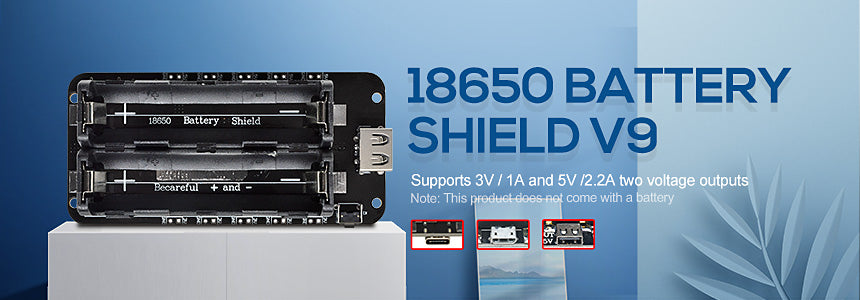Soil Moisture Controller Module Board Kit Automatic Watering Device Automatic Watering DIY Electronic Production Parts Diy Kit
Soil Moisture Controller Module Board Kit Automatic Watering Device Automatic Watering DIY Electronic Production Parts Diy Kit
SKU:X13058- guaranteeQuality checked
- Special gift cardsSpecial gift cards
- Free return Within 60 days
- Consultancy86-0755-85201155

product manual:
The soil moisture controller detects the soil moisture through the soil moisture sensor (fork-shaped circuit board). The soil moisture sensor is not conductive in the air. After inserting the soil, the more moisture in the soil, the resistance on the two terminals of the humidity sensor. The lower, the greater the resistance. The sensor's signal is connected to the control circuit through the J2 probe interface. The resistor R2 is connected in series on the humidity probe. The change in humidity is reflected as the change in the voltage at the inverting input of the voltage comparator U1A. If it is lower than the voltage at the same input terminal of U1A, the comparator outputs a high level, otherwise the output is low. Flat, capacitor C2 is a stable output signal to prevent the relay frequency from operating when the humidity is detected. The self-locking switch J3 is used to control the action mode of the relay (whether the high-level pull-in relay is outputted in the first leg of U1A or the low-level pull-in relay in the first leg of U1A). Pay attention to the direction when installing the self-locking switch. The self-locking switch has a raised short vertical line on one side that matches the short side of the mounting position on the PCB. Adjustable resistor R3 is used to adjust the humidity control value. The relay output terminal J4 can be used as an electrical switch for some high-power appliances, such as pumps, sprays and other machinery. Thereby achieving automatic control. Light-emitting diode D1 is the control board power supply indication, and D2 is the relay pull-in action indication. Transistor Q1 can be seen as a non-gate.
Load: 250V 10A AC or 30V 10A DC (currents below this range can be used);


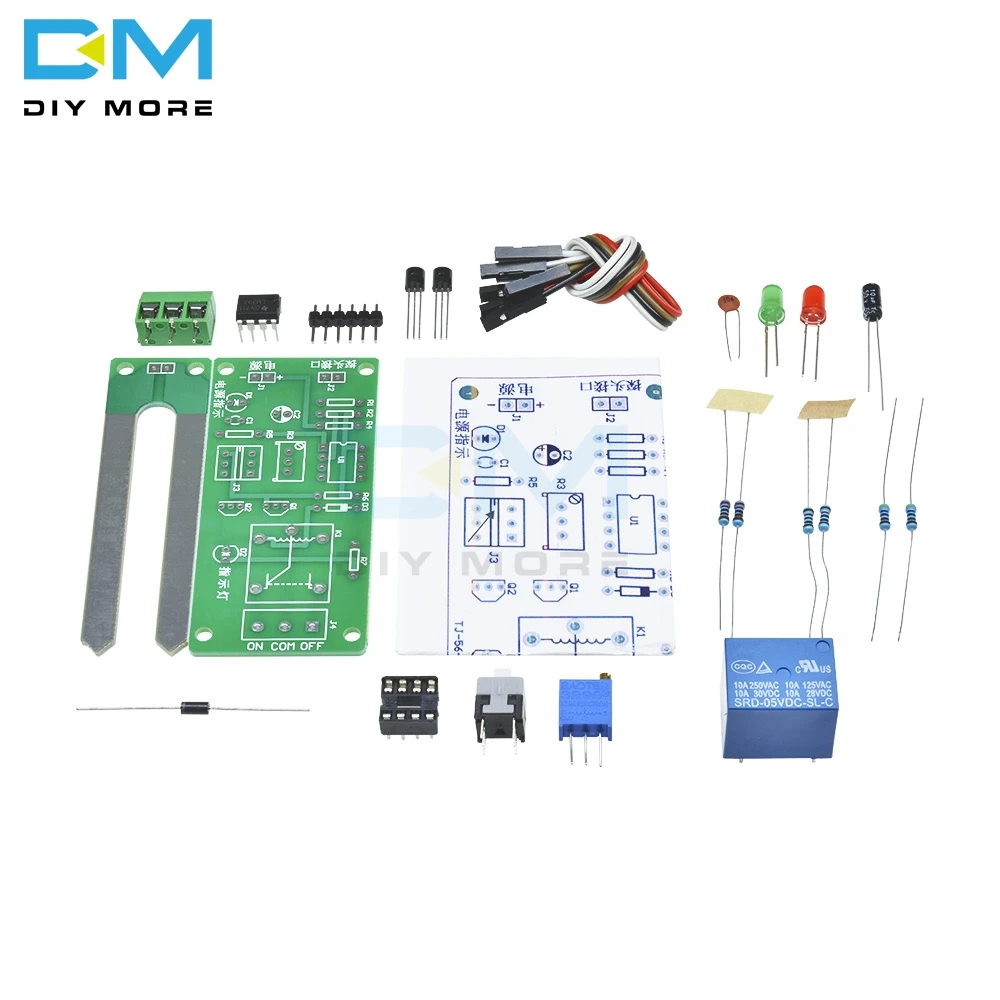





Purchasing & Delivery
Before you make your purchase, it’s helpful to know the measurements of the area you plan to place the furniture. You should also measure any doorways and hallways through which the furniture will pass to get to its final destination.Picking up at the store
Shopify Shop requires that all products are properly inspected BEFORE you take it home to insure there are no surprises. Our team is happy to open all packages and will assist in the inspection process. We will then reseal packages for safe transport. We encourage all customers to bring furniture pads or blankets to protect the items during transport as well as rope or tie downs. Shopify Shop will not be responsible for damage that occurs after leaving the store or during transit. It is the purchaser’s responsibility to make sure the correct items are picked up and in good condition.Delivery
Customers are able to pick the next available delivery day that best fits their schedule. However, to route stops as efficiently as possible, Shopify Shop will provide the time frame. Customers will not be able to choose a time. You will be notified in advance of your scheduled time frame. Please make sure that a responsible adult (18 years or older) will be home at that time.In preparation for your delivery, please remove existing furniture, pictures, mirrors, accessories, etc. to prevent damages. Also insure that the area where you would like your furniture placed is clear of any old furniture and any other items that may obstruct the passageway of the delivery team. Shopify Shop will deliver, assemble, and set-up your new furniture purchase and remove all packing materials from your home. Our delivery crews are not permitted to move your existing furniture or other household items. Delivery personnel will attempt to deliver the purchased items in a safe and controlled manner but will not attempt to place furniture if they feel it will result in damage to the product or your home. Delivery personnel are unable to remove doors, hoist furniture or carry furniture up more than 3 flights of stairs. An elevator must be available for deliveries to the 4th floor and above.
Other Customers also buy:
-
Translation missing: en.products.product.regular_price $5.99 USD{"id":2517126414394,"title":"Soil Moisture Controller Module Board Kit Automatic Watering Device Automatic Watering DIY Electronic Production Parts Diy Kit","handle":"soil-moisture-controller-module-board-kit-automatic-watering-device-automatic-watering-diy-electronic-production-parts-diy-kit","description":"\u003cwidget data-widget-type=\"customText\" id=\"33684419\" title=\"Head\" type=\"custom\"\u003e\u003c\/widget\u003e\n\u003cp\u003e \u003c\/p\u003e\n\u003cp\u003e \u003c\/p\u003e\n\u003cp\u003e\u003cimg src=\"http:\/\/ae01.alicdn.com\/kf\/HTB12JMgilsmBKNjSZFsq6yXSVXaS.jpg\"\u003e\u003c\/p\u003e\n\u003cp\u003e \u003c\/p\u003e\n\u003cp\u003e \u003c\/p\u003e\n\u003cp\u003e\u003cspan\u003e\u003cspan\u003e\u003cspan style=\"font-size: 18px; font-family: trebuchet ms;\"\u003eproduct manual:\u003c\/span\u003e\u003cbr\u003e\u003cbr\u003e\u003cspan style=\"font-size: 18px; font-family: trebuchet ms;\"\u003e \u003c\/span\u003e\u003c\/span\u003e\u003cspan style=\"font-size: 18px; font-family: trebuchet ms;\"\u003eThe soil moisture controller detects the soil moisture through the soil moisture sensor (fork-shaped circuit board). The soil moisture sensor is not conductive in the air. After inserting the soil, the more moisture in the soil, the resistance on the two terminals of the humidity sensor. \u003c\/span\u003e\u003cspan style=\"font-size: 18px; font-family: trebuchet ms;\"\u003eThe lower, the greater the resistance. \u003c\/span\u003e\u003cspan style=\"font-size: 18px; font-family: trebuchet ms;\"\u003eThe sensor's signal is connected to the control circuit through the J2 probe interface. \u003c\/span\u003e\u003cspan style=\"font-size: 18px; font-family: trebuchet ms;\"\u003eThe resistor R2 is connected in series on the humidity probe. The change in humidity is reflected as the change in the voltage at the inverting input of the voltage comparator U1A. If it is lower than the voltage at the same input terminal of U1A, the comparator outputs a high level, otherwise the output is low. \u003c\/span\u003e\u003cspan style=\"font-size: 18px; font-family: trebuchet ms;\"\u003eFlat, capacitor C2 is a stable output signal to prevent the relay frequency from operating when the humidity is detected. \u003c\/span\u003e\u003cspan style=\"font-size: 18px; font-family: trebuchet ms;\"\u003eThe self-locking switch J3 is used to control the action mode of the relay (whether the high-level pull-in relay is outputted in the first leg of U1A or the low-level pull-in relay in the first leg of U1A). Pay attention to the direction when installing the self-locking switch. \u003c\/span\u003e\u003cspan style=\"font-size: 18px; font-family: trebuchet ms;\"\u003eThe self-locking switch has a raised short vertical line on one side that matches the short side of the mounting position on the PCB. \u003c\/span\u003e\u003cspan style=\"font-size: 18px; font-family: trebuchet ms;\"\u003eAdjustable resistor R3 is used to adjust the humidity control value. \u003c\/span\u003e\u003cspan style=\"font-size: 18px; font-family: trebuchet ms;\"\u003eThe relay output terminal J4 can be used as an electrical switch for some high-power appliances, such as pumps, sprays and other machinery. \u003c\/span\u003e\u003cspan style=\"font-size: 18px; font-family: trebuchet ms;\"\u003eThereby achieving automatic control. \u003c\/span\u003e\u003cspan style=\"font-size: 18px; font-family: trebuchet ms;\"\u003eLight-emitting diode D1 is the control board power supply indication, and D2 is the relay pull-in action indication. \u003c\/span\u003e\u003cspan\u003e\u003cspan style=\"font-size: 18px; font-family: trebuchet ms;\"\u003eTransistor Q1 can be seen as a non-gate.\u003c\/span\u003e\u003cbr\u003e\u003c\/span\u003e\u003c\/span\u003e\u003c\/p\u003e\n\u003cp\u003e \u003c\/p\u003e\n\u003cp\u003e\u003cbr\u003e \u003c\/p\u003e\n\u003cspan\u003e\u003cspan\u003e\u003cspan\u003e\u003c\/span\u003e\u003cspan\u003e\u003cspan style=\"font-size: 18px; font-family: trebuchet ms;\"\u003eWorking voltage: 5V DC voltage\u003c\/span\u003e\u003cbr\u003e\u003cbr\u003e\u003c\/span\u003e\u003cspan style=\"font-size: 18px; font-family: trebuchet ms;\"\u003eLoad: 250V 10A AC or 30V 10A DC (currents below this range can be used);\u003c\/span\u003e\u003c\/span\u003e\u003c\/span\u003e\n\u003cp\u003e \u003c\/p\u003e\n\u003cp\u003e\u003cspan style=\"font-size: 18px; font-family: trebuchet ms;\"\u003e\u003c\/span\u003e \u003c\/p\u003e\n\u003cp\u003e\u003cimg src=\"http:\/\/ae01.alicdn.com\/kf\/HTB1VXjubuUXBuNjt_a0q6AysXXaA.jpg\"\u003e\u003c\/p\u003e\n\u003cp\u003e \u003c\/p\u003e\n\u003cp\u003e \u003c\/p\u003e\n\u003cp\u003e \u003c\/p\u003e\n\u003cp\u003e \u003c\/p\u003e\n\u003cp\u003e \u003c\/p\u003e\n\u003cp\u003e\u003cimg style=\"width: 1000px;\" src=\"http:\/\/ae01.alicdn.com\/kf\/He30ac5e629f54bfcbedeb7c996a60eca1.jpg\"\u003e\u003c\/p\u003e\n\u003cp\u003e\u003cimg style=\"width: 1000px;\" src=\"http:\/\/ae01.alicdn.com\/kf\/Hb57a3f4e9b304e0886c68a6e1d8e9bbb2.jpg\"\u003e\u003c\/p\u003e\n\u003cp\u003e\u003cimg style=\"width: 1000px;\" src=\"http:\/\/ae01.alicdn.com\/kf\/H3179619a6a874bffa1bd6d09ec09b714I.jpg\"\u003e\u003c\/p\u003e\n\u003cp\u003e\u003cimg style=\"width: 1000px;\" src=\"http:\/\/ae01.alicdn.com\/kf\/Hd815a8dae9f04cda90352a394f57913cH.jpg\"\u003e\u003c\/p\u003e\n\u003cp\u003e\u003cimg style=\"width: 1000px;\" src=\"http:\/\/ae01.alicdn.com\/kf\/H52381604fbfb4b88900e2ba5f5bec75a1.jpg\"\u003e\u003c\/p\u003e\n\u003cp\u003e\u003cimg style=\"width: 1000px;\" src=\"http:\/\/ae01.alicdn.com\/kf\/H8bfa68f56f0d448b84b9f19790b1a171s.jpg\"\u003e\u003c\/p\u003e\n\u003cp\u003e \u003c\/p\u003e\n\u003cp\u003e \u003c\/p\u003e\n\u003cp\u003e \u003c\/p\u003e\n\u003cp\u003e \u003c\/p\u003e\n\u003cp\u003e\u003cimg src=\"http:\/\/ae01.alicdn.com\/kf\/HTB1Hc.uimcqBKNjSZFgq6x_kXXaq.jpg\"\u003e\u003c\/p\u003e\n\u003cp\u003e \u003c\/p\u003e\n\u003cp\u003e \u003c\/p\u003e\n \n\u003cp\u003e \u003c\/p\u003e","published_at":"2019-09-17T21:05:49+08:00","created_at":"2019-09-17T21:05:50+08:00","vendor":"diymore","type":"Function DIY","tags":["Kits","Relay"],"price":599,"price_min":599,"price_max":599,"available":true,"price_varies":false,"compare_at_price":null,"compare_at_price_min":0,"compare_at_price_max":0,"compare_at_price_varies":false,"variants":[{"id":23727140077626,"title":"Default Title","option1":"Default Title","option2":null,"option3":null,"sku":"X13058","requires_shipping":true,"taxable":false,"featured_image":null,"available":true,"name":"Soil Moisture Controller Module Board Kit Automatic Watering Device Automatic Watering DIY Electronic Production Parts Diy Kit","public_title":null,"options":["Default Title"],"price":599,"weight":30,"compare_at_price":null,"inventory_management":null,"barcode":"","requires_selling_plan":false,"selling_plan_allocations":[]}],"images":["\/\/www.diymore.cc\/cdn\/shop\/products\/X13058_6_972.jpg?v=1588662809","\/\/www.diymore.cc\/cdn\/shop\/products\/X13058_1_283.jpg?v=1588662809","\/\/www.diymore.cc\/cdn\/shop\/products\/X13058_2_456.jpg?v=1588662809","\/\/www.diymore.cc\/cdn\/shop\/products\/X13058_4_983.jpg?v=1588662809","\/\/www.diymore.cc\/cdn\/shop\/products\/X13058_5_681.jpg?v=1588662809","\/\/www.diymore.cc\/cdn\/shop\/products\/X13058_7_447.jpg?v=1588662809","\/\/www.diymore.cc\/cdn\/shop\/products\/X13058_3_975.jpg?v=1588662809"],"featured_image":"\/\/www.diymore.cc\/cdn\/shop\/products\/X13058_6_972.jpg?v=1588662809","options":["Title"],"media":[{"alt":"Soil Moisture Controller Module Board Kit Automatic Watering Device Diy Electronic Production Parts","id":6679235526727,"position":1,"preview_image":{"aspect_ratio":1.0,"height":1000,"width":1000,"src":"\/\/www.diymore.cc\/cdn\/shop\/products\/X13058_6_972.jpg?v=1588662809"},"aspect_ratio":1.0,"height":1000,"media_type":"image","src":"\/\/www.diymore.cc\/cdn\/shop\/products\/X13058_6_972.jpg?v=1588662809","width":1000},{"alt":"Soil Moisture Controller Module Board Kit Automatic Watering Device Diy Electronic Production Parts","id":6679236083783,"position":2,"preview_image":{"aspect_ratio":1.0,"height":1000,"width":1000,"src":"\/\/www.diymore.cc\/cdn\/shop\/products\/X13058_1_283.jpg?v=1588662809"},"aspect_ratio":1.0,"height":1000,"media_type":"image","src":"\/\/www.diymore.cc\/cdn\/shop\/products\/X13058_1_283.jpg?v=1588662809","width":1000},{"alt":"Soil Moisture Controller Module Board Kit Automatic Watering Device Diy Electronic Production Parts","id":6679236313159,"position":3,"preview_image":{"aspect_ratio":1.0,"height":1000,"width":1000,"src":"\/\/www.diymore.cc\/cdn\/shop\/products\/X13058_2_456.jpg?v=1588662809"},"aspect_ratio":1.0,"height":1000,"media_type":"image","src":"\/\/www.diymore.cc\/cdn\/shop\/products\/X13058_2_456.jpg?v=1588662809","width":1000},{"alt":"Soil Moisture Controller Module Board Kit Automatic Watering Device Diy Electronic Production Parts","id":6679236706375,"position":4,"preview_image":{"aspect_ratio":1.0,"height":1000,"width":1000,"src":"\/\/www.diymore.cc\/cdn\/shop\/products\/X13058_4_983.jpg?v=1588662809"},"aspect_ratio":1.0,"height":1000,"media_type":"image","src":"\/\/www.diymore.cc\/cdn\/shop\/products\/X13058_4_983.jpg?v=1588662809","width":1000},{"alt":"Soil Moisture Controller Module Board Kit Automatic Watering Device Diy Electronic Production Parts","id":6679236837447,"position":5,"preview_image":{"aspect_ratio":1.0,"height":1000,"width":1000,"src":"\/\/www.diymore.cc\/cdn\/shop\/products\/X13058_5_681.jpg?v=1588662809"},"aspect_ratio":1.0,"height":1000,"media_type":"image","src":"\/\/www.diymore.cc\/cdn\/shop\/products\/X13058_5_681.jpg?v=1588662809","width":1000},{"alt":"Soil Moisture Controller Module Board Kit Automatic Watering Device Diy Electronic Production Parts","id":6679237034055,"position":6,"preview_image":{"aspect_ratio":1.0,"height":1000,"width":1000,"src":"\/\/www.diymore.cc\/cdn\/shop\/products\/X13058_7_447.jpg?v=1588662809"},"aspect_ratio":1.0,"height":1000,"media_type":"image","src":"\/\/www.diymore.cc\/cdn\/shop\/products\/X13058_7_447.jpg?v=1588662809","width":1000},{"alt":"Soil Moisture Controller Module Board Kit Automatic Watering Device Diy Electronic Production Parts","id":6679238017095,"position":7,"preview_image":{"aspect_ratio":1.0,"height":1000,"width":1000,"src":"\/\/www.diymore.cc\/cdn\/shop\/products\/X13058_3_975.jpg?v=1588662809"},"aspect_ratio":1.0,"height":1000,"media_type":"image","src":"\/\/www.diymore.cc\/cdn\/shop\/products\/X13058_3_975.jpg?v=1588662809","width":1000}],"requires_selling_plan":false,"selling_plan_groups":[],"content":"\u003cwidget data-widget-type=\"customText\" id=\"33684419\" title=\"Head\" type=\"custom\"\u003e\u003c\/widget\u003e\n\u003cp\u003e \u003c\/p\u003e\n\u003cp\u003e \u003c\/p\u003e\n\u003cp\u003e\u003cimg src=\"http:\/\/ae01.alicdn.com\/kf\/HTB12JMgilsmBKNjSZFsq6yXSVXaS.jpg\"\u003e\u003c\/p\u003e\n\u003cp\u003e \u003c\/p\u003e\n\u003cp\u003e \u003c\/p\u003e\n\u003cp\u003e\u003cspan\u003e\u003cspan\u003e\u003cspan style=\"font-size: 18px; font-family: trebuchet ms;\"\u003eproduct manual:\u003c\/span\u003e\u003cbr\u003e\u003cbr\u003e\u003cspan style=\"font-size: 18px; font-family: trebuchet ms;\"\u003e \u003c\/span\u003e\u003c\/span\u003e\u003cspan style=\"font-size: 18px; font-family: trebuchet ms;\"\u003eThe soil moisture controller detects the soil moisture through the soil moisture sensor (fork-shaped circuit board). The soil moisture sensor is not conductive in the air. After inserting the soil, the more moisture in the soil, the resistance on the two terminals of the humidity sensor. \u003c\/span\u003e\u003cspan style=\"font-size: 18px; font-family: trebuchet ms;\"\u003eThe lower, the greater the resistance. \u003c\/span\u003e\u003cspan style=\"font-size: 18px; font-family: trebuchet ms;\"\u003eThe sensor's signal is connected to the control circuit through the J2 probe interface. \u003c\/span\u003e\u003cspan style=\"font-size: 18px; font-family: trebuchet ms;\"\u003eThe resistor R2 is connected in series on the humidity probe. The change in humidity is reflected as the change in the voltage at the inverting input of the voltage comparator U1A. If it is lower than the voltage at the same input terminal of U1A, the comparator outputs a high level, otherwise the output is low. \u003c\/span\u003e\u003cspan style=\"font-size: 18px; font-family: trebuchet ms;\"\u003eFlat, capacitor C2 is a stable output signal to prevent the relay frequency from operating when the humidity is detected. \u003c\/span\u003e\u003cspan style=\"font-size: 18px; font-family: trebuchet ms;\"\u003eThe self-locking switch J3 is used to control the action mode of the relay (whether the high-level pull-in relay is outputted in the first leg of U1A or the low-level pull-in relay in the first leg of U1A). Pay attention to the direction when installing the self-locking switch. \u003c\/span\u003e\u003cspan style=\"font-size: 18px; font-family: trebuchet ms;\"\u003eThe self-locking switch has a raised short vertical line on one side that matches the short side of the mounting position on the PCB. \u003c\/span\u003e\u003cspan style=\"font-size: 18px; font-family: trebuchet ms;\"\u003eAdjustable resistor R3 is used to adjust the humidity control value. \u003c\/span\u003e\u003cspan style=\"font-size: 18px; font-family: trebuchet ms;\"\u003eThe relay output terminal J4 can be used as an electrical switch for some high-power appliances, such as pumps, sprays and other machinery. \u003c\/span\u003e\u003cspan style=\"font-size: 18px; font-family: trebuchet ms;\"\u003eThereby achieving automatic control. \u003c\/span\u003e\u003cspan style=\"font-size: 18px; font-family: trebuchet ms;\"\u003eLight-emitting diode D1 is the control board power supply indication, and D2 is the relay pull-in action indication. \u003c\/span\u003e\u003cspan\u003e\u003cspan style=\"font-size: 18px; font-family: trebuchet ms;\"\u003eTransistor Q1 can be seen as a non-gate.\u003c\/span\u003e\u003cbr\u003e\u003c\/span\u003e\u003c\/span\u003e\u003c\/p\u003e\n\u003cp\u003e \u003c\/p\u003e\n\u003cp\u003e\u003cbr\u003e \u003c\/p\u003e\n\u003cspan\u003e\u003cspan\u003e\u003cspan\u003e\u003c\/span\u003e\u003cspan\u003e\u003cspan style=\"font-size: 18px; font-family: trebuchet ms;\"\u003eWorking voltage: 5V DC voltage\u003c\/span\u003e\u003cbr\u003e\u003cbr\u003e\u003c\/span\u003e\u003cspan style=\"font-size: 18px; font-family: trebuchet ms;\"\u003eLoad: 250V 10A AC or 30V 10A DC (currents below this range can be used);\u003c\/span\u003e\u003c\/span\u003e\u003c\/span\u003e\n\u003cp\u003e \u003c\/p\u003e\n\u003cp\u003e\u003cspan style=\"font-size: 18px; font-family: trebuchet ms;\"\u003e\u003c\/span\u003e \u003c\/p\u003e\n\u003cp\u003e\u003cimg src=\"http:\/\/ae01.alicdn.com\/kf\/HTB1VXjubuUXBuNjt_a0q6AysXXaA.jpg\"\u003e\u003c\/p\u003e\n\u003cp\u003e \u003c\/p\u003e\n\u003cp\u003e \u003c\/p\u003e\n\u003cp\u003e \u003c\/p\u003e\n\u003cp\u003e \u003c\/p\u003e\n\u003cp\u003e \u003c\/p\u003e\n\u003cp\u003e\u003cimg style=\"width: 1000px;\" src=\"http:\/\/ae01.alicdn.com\/kf\/He30ac5e629f54bfcbedeb7c996a60eca1.jpg\"\u003e\u003c\/p\u003e\n\u003cp\u003e\u003cimg style=\"width: 1000px;\" src=\"http:\/\/ae01.alicdn.com\/kf\/Hb57a3f4e9b304e0886c68a6e1d8e9bbb2.jpg\"\u003e\u003c\/p\u003e\n\u003cp\u003e\u003cimg style=\"width: 1000px;\" src=\"http:\/\/ae01.alicdn.com\/kf\/H3179619a6a874bffa1bd6d09ec09b714I.jpg\"\u003e\u003c\/p\u003e\n\u003cp\u003e\u003cimg style=\"width: 1000px;\" src=\"http:\/\/ae01.alicdn.com\/kf\/Hd815a8dae9f04cda90352a394f57913cH.jpg\"\u003e\u003c\/p\u003e\n\u003cp\u003e\u003cimg style=\"width: 1000px;\" src=\"http:\/\/ae01.alicdn.com\/kf\/H52381604fbfb4b88900e2ba5f5bec75a1.jpg\"\u003e\u003c\/p\u003e\n\u003cp\u003e\u003cimg style=\"width: 1000px;\" src=\"http:\/\/ae01.alicdn.com\/kf\/H8bfa68f56f0d448b84b9f19790b1a171s.jpg\"\u003e\u003c\/p\u003e\n\u003cp\u003e \u003c\/p\u003e\n\u003cp\u003e \u003c\/p\u003e\n\u003cp\u003e \u003c\/p\u003e\n\u003cp\u003e \u003c\/p\u003e\n\u003cp\u003e\u003cimg src=\"http:\/\/ae01.alicdn.com\/kf\/HTB1Hc.uimcqBKNjSZFgq6x_kXXaq.jpg\"\u003e\u003c\/p\u003e\n\u003cp\u003e \u003c\/p\u003e\n\u003cp\u003e \u003c\/p\u003e\n \n\u003cp\u003e \u003c\/p\u003e"}
-
Translation missing: en.products.product.regular_price $4.99 USD{"id":2517126414394,"title":"Soil Moisture Controller Module Board Kit Automatic Watering Device Automatic Watering DIY Electronic Production Parts Diy Kit","handle":"soil-moisture-controller-module-board-kit-automatic-watering-device-automatic-watering-diy-electronic-production-parts-diy-kit","description":"\u003cwidget data-widget-type=\"customText\" id=\"33684419\" title=\"Head\" type=\"custom\"\u003e\u003c\/widget\u003e\n\u003cp\u003e \u003c\/p\u003e\n\u003cp\u003e \u003c\/p\u003e\n\u003cp\u003e\u003cimg src=\"http:\/\/ae01.alicdn.com\/kf\/HTB12JMgilsmBKNjSZFsq6yXSVXaS.jpg\"\u003e\u003c\/p\u003e\n\u003cp\u003e \u003c\/p\u003e\n\u003cp\u003e \u003c\/p\u003e\n\u003cp\u003e\u003cspan\u003e\u003cspan\u003e\u003cspan style=\"font-size: 18px; font-family: trebuchet ms;\"\u003eproduct manual:\u003c\/span\u003e\u003cbr\u003e\u003cbr\u003e\u003cspan style=\"font-size: 18px; font-family: trebuchet ms;\"\u003e \u003c\/span\u003e\u003c\/span\u003e\u003cspan style=\"font-size: 18px; font-family: trebuchet ms;\"\u003eThe soil moisture controller detects the soil moisture through the soil moisture sensor (fork-shaped circuit board). The soil moisture sensor is not conductive in the air. After inserting the soil, the more moisture in the soil, the resistance on the two terminals of the humidity sensor. \u003c\/span\u003e\u003cspan style=\"font-size: 18px; font-family: trebuchet ms;\"\u003eThe lower, the greater the resistance. \u003c\/span\u003e\u003cspan style=\"font-size: 18px; font-family: trebuchet ms;\"\u003eThe sensor's signal is connected to the control circuit through the J2 probe interface. \u003c\/span\u003e\u003cspan style=\"font-size: 18px; font-family: trebuchet ms;\"\u003eThe resistor R2 is connected in series on the humidity probe. The change in humidity is reflected as the change in the voltage at the inverting input of the voltage comparator U1A. If it is lower than the voltage at the same input terminal of U1A, the comparator outputs a high level, otherwise the output is low. \u003c\/span\u003e\u003cspan style=\"font-size: 18px; font-family: trebuchet ms;\"\u003eFlat, capacitor C2 is a stable output signal to prevent the relay frequency from operating when the humidity is detected. \u003c\/span\u003e\u003cspan style=\"font-size: 18px; font-family: trebuchet ms;\"\u003eThe self-locking switch J3 is used to control the action mode of the relay (whether the high-level pull-in relay is outputted in the first leg of U1A or the low-level pull-in relay in the first leg of U1A). Pay attention to the direction when installing the self-locking switch. \u003c\/span\u003e\u003cspan style=\"font-size: 18px; font-family: trebuchet ms;\"\u003eThe self-locking switch has a raised short vertical line on one side that matches the short side of the mounting position on the PCB. \u003c\/span\u003e\u003cspan style=\"font-size: 18px; font-family: trebuchet ms;\"\u003eAdjustable resistor R3 is used to adjust the humidity control value. \u003c\/span\u003e\u003cspan style=\"font-size: 18px; font-family: trebuchet ms;\"\u003eThe relay output terminal J4 can be used as an electrical switch for some high-power appliances, such as pumps, sprays and other machinery. \u003c\/span\u003e\u003cspan style=\"font-size: 18px; font-family: trebuchet ms;\"\u003eThereby achieving automatic control. \u003c\/span\u003e\u003cspan style=\"font-size: 18px; font-family: trebuchet ms;\"\u003eLight-emitting diode D1 is the control board power supply indication, and D2 is the relay pull-in action indication. \u003c\/span\u003e\u003cspan\u003e\u003cspan style=\"font-size: 18px; font-family: trebuchet ms;\"\u003eTransistor Q1 can be seen as a non-gate.\u003c\/span\u003e\u003cbr\u003e\u003c\/span\u003e\u003c\/span\u003e\u003c\/p\u003e\n\u003cp\u003e \u003c\/p\u003e\n\u003cp\u003e\u003cbr\u003e \u003c\/p\u003e\n\u003cspan\u003e\u003cspan\u003e\u003cspan\u003e\u003c\/span\u003e\u003cspan\u003e\u003cspan style=\"font-size: 18px; font-family: trebuchet ms;\"\u003eWorking voltage: 5V DC voltage\u003c\/span\u003e\u003cbr\u003e\u003cbr\u003e\u003c\/span\u003e\u003cspan style=\"font-size: 18px; font-family: trebuchet ms;\"\u003eLoad: 250V 10A AC or 30V 10A DC (currents below this range can be used);\u003c\/span\u003e\u003c\/span\u003e\u003c\/span\u003e\n\u003cp\u003e \u003c\/p\u003e\n\u003cp\u003e\u003cspan style=\"font-size: 18px; font-family: trebuchet ms;\"\u003e\u003c\/span\u003e \u003c\/p\u003e\n\u003cp\u003e\u003cimg src=\"http:\/\/ae01.alicdn.com\/kf\/HTB1VXjubuUXBuNjt_a0q6AysXXaA.jpg\"\u003e\u003c\/p\u003e\n\u003cp\u003e \u003c\/p\u003e\n\u003cp\u003e \u003c\/p\u003e\n\u003cp\u003e \u003c\/p\u003e\n\u003cp\u003e \u003c\/p\u003e\n\u003cp\u003e \u003c\/p\u003e\n\u003cp\u003e\u003cimg style=\"width: 1000px;\" src=\"http:\/\/ae01.alicdn.com\/kf\/He30ac5e629f54bfcbedeb7c996a60eca1.jpg\"\u003e\u003c\/p\u003e\n\u003cp\u003e\u003cimg style=\"width: 1000px;\" src=\"http:\/\/ae01.alicdn.com\/kf\/Hb57a3f4e9b304e0886c68a6e1d8e9bbb2.jpg\"\u003e\u003c\/p\u003e\n\u003cp\u003e\u003cimg style=\"width: 1000px;\" src=\"http:\/\/ae01.alicdn.com\/kf\/H3179619a6a874bffa1bd6d09ec09b714I.jpg\"\u003e\u003c\/p\u003e\n\u003cp\u003e\u003cimg style=\"width: 1000px;\" src=\"http:\/\/ae01.alicdn.com\/kf\/Hd815a8dae9f04cda90352a394f57913cH.jpg\"\u003e\u003c\/p\u003e\n\u003cp\u003e\u003cimg style=\"width: 1000px;\" src=\"http:\/\/ae01.alicdn.com\/kf\/H52381604fbfb4b88900e2ba5f5bec75a1.jpg\"\u003e\u003c\/p\u003e\n\u003cp\u003e\u003cimg style=\"width: 1000px;\" src=\"http:\/\/ae01.alicdn.com\/kf\/H8bfa68f56f0d448b84b9f19790b1a171s.jpg\"\u003e\u003c\/p\u003e\n\u003cp\u003e \u003c\/p\u003e\n\u003cp\u003e \u003c\/p\u003e\n\u003cp\u003e \u003c\/p\u003e\n\u003cp\u003e \u003c\/p\u003e\n\u003cp\u003e\u003cimg src=\"http:\/\/ae01.alicdn.com\/kf\/HTB1Hc.uimcqBKNjSZFgq6x_kXXaq.jpg\"\u003e\u003c\/p\u003e\n\u003cp\u003e \u003c\/p\u003e\n\u003cp\u003e \u003c\/p\u003e\n \n\u003cp\u003e \u003c\/p\u003e","published_at":"2019-09-17T21:05:49+08:00","created_at":"2019-09-17T21:05:50+08:00","vendor":"diymore","type":"Function DIY","tags":["Kits","Relay"],"price":599,"price_min":599,"price_max":599,"available":true,"price_varies":false,"compare_at_price":null,"compare_at_price_min":0,"compare_at_price_max":0,"compare_at_price_varies":false,"variants":[{"id":23727140077626,"title":"Default Title","option1":"Default Title","option2":null,"option3":null,"sku":"X13058","requires_shipping":true,"taxable":false,"featured_image":null,"available":true,"name":"Soil Moisture Controller Module Board Kit Automatic Watering Device Automatic Watering DIY Electronic Production Parts Diy Kit","public_title":null,"options":["Default Title"],"price":599,"weight":30,"compare_at_price":null,"inventory_management":null,"barcode":"","requires_selling_plan":false,"selling_plan_allocations":[]}],"images":["\/\/www.diymore.cc\/cdn\/shop\/products\/X13058_6_972.jpg?v=1588662809","\/\/www.diymore.cc\/cdn\/shop\/products\/X13058_1_283.jpg?v=1588662809","\/\/www.diymore.cc\/cdn\/shop\/products\/X13058_2_456.jpg?v=1588662809","\/\/www.diymore.cc\/cdn\/shop\/products\/X13058_4_983.jpg?v=1588662809","\/\/www.diymore.cc\/cdn\/shop\/products\/X13058_5_681.jpg?v=1588662809","\/\/www.diymore.cc\/cdn\/shop\/products\/X13058_7_447.jpg?v=1588662809","\/\/www.diymore.cc\/cdn\/shop\/products\/X13058_3_975.jpg?v=1588662809"],"featured_image":"\/\/www.diymore.cc\/cdn\/shop\/products\/X13058_6_972.jpg?v=1588662809","options":["Title"],"media":[{"alt":"Soil Moisture Controller Module Board Kit Automatic Watering Device Diy Electronic Production Parts","id":6679235526727,"position":1,"preview_image":{"aspect_ratio":1.0,"height":1000,"width":1000,"src":"\/\/www.diymore.cc\/cdn\/shop\/products\/X13058_6_972.jpg?v=1588662809"},"aspect_ratio":1.0,"height":1000,"media_type":"image","src":"\/\/www.diymore.cc\/cdn\/shop\/products\/X13058_6_972.jpg?v=1588662809","width":1000},{"alt":"Soil Moisture Controller Module Board Kit Automatic Watering Device Diy Electronic Production Parts","id":6679236083783,"position":2,"preview_image":{"aspect_ratio":1.0,"height":1000,"width":1000,"src":"\/\/www.diymore.cc\/cdn\/shop\/products\/X13058_1_283.jpg?v=1588662809"},"aspect_ratio":1.0,"height":1000,"media_type":"image","src":"\/\/www.diymore.cc\/cdn\/shop\/products\/X13058_1_283.jpg?v=1588662809","width":1000},{"alt":"Soil Moisture Controller Module Board Kit Automatic Watering Device Diy Electronic Production Parts","id":6679236313159,"position":3,"preview_image":{"aspect_ratio":1.0,"height":1000,"width":1000,"src":"\/\/www.diymore.cc\/cdn\/shop\/products\/X13058_2_456.jpg?v=1588662809"},"aspect_ratio":1.0,"height":1000,"media_type":"image","src":"\/\/www.diymore.cc\/cdn\/shop\/products\/X13058_2_456.jpg?v=1588662809","width":1000},{"alt":"Soil Moisture Controller Module Board Kit Automatic Watering Device Diy Electronic Production Parts","id":6679236706375,"position":4,"preview_image":{"aspect_ratio":1.0,"height":1000,"width":1000,"src":"\/\/www.diymore.cc\/cdn\/shop\/products\/X13058_4_983.jpg?v=1588662809"},"aspect_ratio":1.0,"height":1000,"media_type":"image","src":"\/\/www.diymore.cc\/cdn\/shop\/products\/X13058_4_983.jpg?v=1588662809","width":1000},{"alt":"Soil Moisture Controller Module Board Kit Automatic Watering Device Diy Electronic Production Parts","id":6679236837447,"position":5,"preview_image":{"aspect_ratio":1.0,"height":1000,"width":1000,"src":"\/\/www.diymore.cc\/cdn\/shop\/products\/X13058_5_681.jpg?v=1588662809"},"aspect_ratio":1.0,"height":1000,"media_type":"image","src":"\/\/www.diymore.cc\/cdn\/shop\/products\/X13058_5_681.jpg?v=1588662809","width":1000},{"alt":"Soil Moisture Controller Module Board Kit Automatic Watering Device Diy Electronic Production Parts","id":6679237034055,"position":6,"preview_image":{"aspect_ratio":1.0,"height":1000,"width":1000,"src":"\/\/www.diymore.cc\/cdn\/shop\/products\/X13058_7_447.jpg?v=1588662809"},"aspect_ratio":1.0,"height":1000,"media_type":"image","src":"\/\/www.diymore.cc\/cdn\/shop\/products\/X13058_7_447.jpg?v=1588662809","width":1000},{"alt":"Soil Moisture Controller Module Board Kit Automatic Watering Device Diy Electronic Production Parts","id":6679238017095,"position":7,"preview_image":{"aspect_ratio":1.0,"height":1000,"width":1000,"src":"\/\/www.diymore.cc\/cdn\/shop\/products\/X13058_3_975.jpg?v=1588662809"},"aspect_ratio":1.0,"height":1000,"media_type":"image","src":"\/\/www.diymore.cc\/cdn\/shop\/products\/X13058_3_975.jpg?v=1588662809","width":1000}],"requires_selling_plan":false,"selling_plan_groups":[],"content":"\u003cwidget data-widget-type=\"customText\" id=\"33684419\" title=\"Head\" type=\"custom\"\u003e\u003c\/widget\u003e\n\u003cp\u003e \u003c\/p\u003e\n\u003cp\u003e \u003c\/p\u003e\n\u003cp\u003e\u003cimg src=\"http:\/\/ae01.alicdn.com\/kf\/HTB12JMgilsmBKNjSZFsq6yXSVXaS.jpg\"\u003e\u003c\/p\u003e\n\u003cp\u003e \u003c\/p\u003e\n\u003cp\u003e \u003c\/p\u003e\n\u003cp\u003e\u003cspan\u003e\u003cspan\u003e\u003cspan style=\"font-size: 18px; font-family: trebuchet ms;\"\u003eproduct manual:\u003c\/span\u003e\u003cbr\u003e\u003cbr\u003e\u003cspan style=\"font-size: 18px; font-family: trebuchet ms;\"\u003e \u003c\/span\u003e\u003c\/span\u003e\u003cspan style=\"font-size: 18px; font-family: trebuchet ms;\"\u003eThe soil moisture controller detects the soil moisture through the soil moisture sensor (fork-shaped circuit board). The soil moisture sensor is not conductive in the air. After inserting the soil, the more moisture in the soil, the resistance on the two terminals of the humidity sensor. \u003c\/span\u003e\u003cspan style=\"font-size: 18px; font-family: trebuchet ms;\"\u003eThe lower, the greater the resistance. \u003c\/span\u003e\u003cspan style=\"font-size: 18px; font-family: trebuchet ms;\"\u003eThe sensor's signal is connected to the control circuit through the J2 probe interface. \u003c\/span\u003e\u003cspan style=\"font-size: 18px; font-family: trebuchet ms;\"\u003eThe resistor R2 is connected in series on the humidity probe. The change in humidity is reflected as the change in the voltage at the inverting input of the voltage comparator U1A. If it is lower than the voltage at the same input terminal of U1A, the comparator outputs a high level, otherwise the output is low. \u003c\/span\u003e\u003cspan style=\"font-size: 18px; font-family: trebuchet ms;\"\u003eFlat, capacitor C2 is a stable output signal to prevent the relay frequency from operating when the humidity is detected. \u003c\/span\u003e\u003cspan style=\"font-size: 18px; font-family: trebuchet ms;\"\u003eThe self-locking switch J3 is used to control the action mode of the relay (whether the high-level pull-in relay is outputted in the first leg of U1A or the low-level pull-in relay in the first leg of U1A). Pay attention to the direction when installing the self-locking switch. \u003c\/span\u003e\u003cspan style=\"font-size: 18px; font-family: trebuchet ms;\"\u003eThe self-locking switch has a raised short vertical line on one side that matches the short side of the mounting position on the PCB. \u003c\/span\u003e\u003cspan style=\"font-size: 18px; font-family: trebuchet ms;\"\u003eAdjustable resistor R3 is used to adjust the humidity control value. \u003c\/span\u003e\u003cspan style=\"font-size: 18px; font-family: trebuchet ms;\"\u003eThe relay output terminal J4 can be used as an electrical switch for some high-power appliances, such as pumps, sprays and other machinery. \u003c\/span\u003e\u003cspan style=\"font-size: 18px; font-family: trebuchet ms;\"\u003eThereby achieving automatic control. \u003c\/span\u003e\u003cspan style=\"font-size: 18px; font-family: trebuchet ms;\"\u003eLight-emitting diode D1 is the control board power supply indication, and D2 is the relay pull-in action indication. \u003c\/span\u003e\u003cspan\u003e\u003cspan style=\"font-size: 18px; font-family: trebuchet ms;\"\u003eTransistor Q1 can be seen as a non-gate.\u003c\/span\u003e\u003cbr\u003e\u003c\/span\u003e\u003c\/span\u003e\u003c\/p\u003e\n\u003cp\u003e \u003c\/p\u003e\n\u003cp\u003e\u003cbr\u003e \u003c\/p\u003e\n\u003cspan\u003e\u003cspan\u003e\u003cspan\u003e\u003c\/span\u003e\u003cspan\u003e\u003cspan style=\"font-size: 18px; font-family: trebuchet ms;\"\u003eWorking voltage: 5V DC voltage\u003c\/span\u003e\u003cbr\u003e\u003cbr\u003e\u003c\/span\u003e\u003cspan style=\"font-size: 18px; font-family: trebuchet ms;\"\u003eLoad: 250V 10A AC or 30V 10A DC (currents below this range can be used);\u003c\/span\u003e\u003c\/span\u003e\u003c\/span\u003e\n\u003cp\u003e \u003c\/p\u003e\n\u003cp\u003e\u003cspan style=\"font-size: 18px; font-family: trebuchet ms;\"\u003e\u003c\/span\u003e \u003c\/p\u003e\n\u003cp\u003e\u003cimg src=\"http:\/\/ae01.alicdn.com\/kf\/HTB1VXjubuUXBuNjt_a0q6AysXXaA.jpg\"\u003e\u003c\/p\u003e\n\u003cp\u003e \u003c\/p\u003e\n\u003cp\u003e \u003c\/p\u003e\n\u003cp\u003e \u003c\/p\u003e\n\u003cp\u003e \u003c\/p\u003e\n\u003cp\u003e \u003c\/p\u003e\n\u003cp\u003e\u003cimg style=\"width: 1000px;\" src=\"http:\/\/ae01.alicdn.com\/kf\/He30ac5e629f54bfcbedeb7c996a60eca1.jpg\"\u003e\u003c\/p\u003e\n\u003cp\u003e\u003cimg style=\"width: 1000px;\" src=\"http:\/\/ae01.alicdn.com\/kf\/Hb57a3f4e9b304e0886c68a6e1d8e9bbb2.jpg\"\u003e\u003c\/p\u003e\n\u003cp\u003e\u003cimg style=\"width: 1000px;\" src=\"http:\/\/ae01.alicdn.com\/kf\/H3179619a6a874bffa1bd6d09ec09b714I.jpg\"\u003e\u003c\/p\u003e\n\u003cp\u003e\u003cimg style=\"width: 1000px;\" src=\"http:\/\/ae01.alicdn.com\/kf\/Hd815a8dae9f04cda90352a394f57913cH.jpg\"\u003e\u003c\/p\u003e\n\u003cp\u003e\u003cimg style=\"width: 1000px;\" src=\"http:\/\/ae01.alicdn.com\/kf\/H52381604fbfb4b88900e2ba5f5bec75a1.jpg\"\u003e\u003c\/p\u003e\n\u003cp\u003e\u003cimg style=\"width: 1000px;\" src=\"http:\/\/ae01.alicdn.com\/kf\/H8bfa68f56f0d448b84b9f19790b1a171s.jpg\"\u003e\u003c\/p\u003e\n\u003cp\u003e \u003c\/p\u003e\n\u003cp\u003e \u003c\/p\u003e\n\u003cp\u003e \u003c\/p\u003e\n\u003cp\u003e \u003c\/p\u003e\n\u003cp\u003e\u003cimg src=\"http:\/\/ae01.alicdn.com\/kf\/HTB1Hc.uimcqBKNjSZFgq6x_kXXaq.jpg\"\u003e\u003c\/p\u003e\n\u003cp\u003e \u003c\/p\u003e\n\u003cp\u003e \u003c\/p\u003e\n \n\u003cp\u003e \u003c\/p\u003e"}
-
Translation missing: en.products.product.regular_price $5.99 USD{"id":2517126414394,"title":"Soil Moisture Controller Module Board Kit Automatic Watering Device Automatic Watering DIY Electronic Production Parts Diy Kit","handle":"soil-moisture-controller-module-board-kit-automatic-watering-device-automatic-watering-diy-electronic-production-parts-diy-kit","description":"\u003cwidget data-widget-type=\"customText\" id=\"33684419\" title=\"Head\" type=\"custom\"\u003e\u003c\/widget\u003e\n\u003cp\u003e \u003c\/p\u003e\n\u003cp\u003e \u003c\/p\u003e\n\u003cp\u003e\u003cimg src=\"http:\/\/ae01.alicdn.com\/kf\/HTB12JMgilsmBKNjSZFsq6yXSVXaS.jpg\"\u003e\u003c\/p\u003e\n\u003cp\u003e \u003c\/p\u003e\n\u003cp\u003e \u003c\/p\u003e\n\u003cp\u003e\u003cspan\u003e\u003cspan\u003e\u003cspan style=\"font-size: 18px; font-family: trebuchet ms;\"\u003eproduct manual:\u003c\/span\u003e\u003cbr\u003e\u003cbr\u003e\u003cspan style=\"font-size: 18px; font-family: trebuchet ms;\"\u003e \u003c\/span\u003e\u003c\/span\u003e\u003cspan style=\"font-size: 18px; font-family: trebuchet ms;\"\u003eThe soil moisture controller detects the soil moisture through the soil moisture sensor (fork-shaped circuit board). The soil moisture sensor is not conductive in the air. After inserting the soil, the more moisture in the soil, the resistance on the two terminals of the humidity sensor. \u003c\/span\u003e\u003cspan style=\"font-size: 18px; font-family: trebuchet ms;\"\u003eThe lower, the greater the resistance. \u003c\/span\u003e\u003cspan style=\"font-size: 18px; font-family: trebuchet ms;\"\u003eThe sensor's signal is connected to the control circuit through the J2 probe interface. \u003c\/span\u003e\u003cspan style=\"font-size: 18px; font-family: trebuchet ms;\"\u003eThe resistor R2 is connected in series on the humidity probe. The change in humidity is reflected as the change in the voltage at the inverting input of the voltage comparator U1A. If it is lower than the voltage at the same input terminal of U1A, the comparator outputs a high level, otherwise the output is low. \u003c\/span\u003e\u003cspan style=\"font-size: 18px; font-family: trebuchet ms;\"\u003eFlat, capacitor C2 is a stable output signal to prevent the relay frequency from operating when the humidity is detected. \u003c\/span\u003e\u003cspan style=\"font-size: 18px; font-family: trebuchet ms;\"\u003eThe self-locking switch J3 is used to control the action mode of the relay (whether the high-level pull-in relay is outputted in the first leg of U1A or the low-level pull-in relay in the first leg of U1A). Pay attention to the direction when installing the self-locking switch. \u003c\/span\u003e\u003cspan style=\"font-size: 18px; font-family: trebuchet ms;\"\u003eThe self-locking switch has a raised short vertical line on one side that matches the short side of the mounting position on the PCB. \u003c\/span\u003e\u003cspan style=\"font-size: 18px; font-family: trebuchet ms;\"\u003eAdjustable resistor R3 is used to adjust the humidity control value. \u003c\/span\u003e\u003cspan style=\"font-size: 18px; font-family: trebuchet ms;\"\u003eThe relay output terminal J4 can be used as an electrical switch for some high-power appliances, such as pumps, sprays and other machinery. \u003c\/span\u003e\u003cspan style=\"font-size: 18px; font-family: trebuchet ms;\"\u003eThereby achieving automatic control. \u003c\/span\u003e\u003cspan style=\"font-size: 18px; font-family: trebuchet ms;\"\u003eLight-emitting diode D1 is the control board power supply indication, and D2 is the relay pull-in action indication. \u003c\/span\u003e\u003cspan\u003e\u003cspan style=\"font-size: 18px; font-family: trebuchet ms;\"\u003eTransistor Q1 can be seen as a non-gate.\u003c\/span\u003e\u003cbr\u003e\u003c\/span\u003e\u003c\/span\u003e\u003c\/p\u003e\n\u003cp\u003e \u003c\/p\u003e\n\u003cp\u003e\u003cbr\u003e \u003c\/p\u003e\n\u003cspan\u003e\u003cspan\u003e\u003cspan\u003e\u003c\/span\u003e\u003cspan\u003e\u003cspan style=\"font-size: 18px; font-family: trebuchet ms;\"\u003eWorking voltage: 5V DC voltage\u003c\/span\u003e\u003cbr\u003e\u003cbr\u003e\u003c\/span\u003e\u003cspan style=\"font-size: 18px; font-family: trebuchet ms;\"\u003eLoad: 250V 10A AC or 30V 10A DC (currents below this range can be used);\u003c\/span\u003e\u003c\/span\u003e\u003c\/span\u003e\n\u003cp\u003e \u003c\/p\u003e\n\u003cp\u003e\u003cspan style=\"font-size: 18px; font-family: trebuchet ms;\"\u003e\u003c\/span\u003e \u003c\/p\u003e\n\u003cp\u003e\u003cimg src=\"http:\/\/ae01.alicdn.com\/kf\/HTB1VXjubuUXBuNjt_a0q6AysXXaA.jpg\"\u003e\u003c\/p\u003e\n\u003cp\u003e \u003c\/p\u003e\n\u003cp\u003e \u003c\/p\u003e\n\u003cp\u003e \u003c\/p\u003e\n\u003cp\u003e \u003c\/p\u003e\n\u003cp\u003e \u003c\/p\u003e\n\u003cp\u003e\u003cimg style=\"width: 1000px;\" src=\"http:\/\/ae01.alicdn.com\/kf\/He30ac5e629f54bfcbedeb7c996a60eca1.jpg\"\u003e\u003c\/p\u003e\n\u003cp\u003e\u003cimg style=\"width: 1000px;\" src=\"http:\/\/ae01.alicdn.com\/kf\/Hb57a3f4e9b304e0886c68a6e1d8e9bbb2.jpg\"\u003e\u003c\/p\u003e\n\u003cp\u003e\u003cimg style=\"width: 1000px;\" src=\"http:\/\/ae01.alicdn.com\/kf\/H3179619a6a874bffa1bd6d09ec09b714I.jpg\"\u003e\u003c\/p\u003e\n\u003cp\u003e\u003cimg style=\"width: 1000px;\" src=\"http:\/\/ae01.alicdn.com\/kf\/Hd815a8dae9f04cda90352a394f57913cH.jpg\"\u003e\u003c\/p\u003e\n\u003cp\u003e\u003cimg style=\"width: 1000px;\" src=\"http:\/\/ae01.alicdn.com\/kf\/H52381604fbfb4b88900e2ba5f5bec75a1.jpg\"\u003e\u003c\/p\u003e\n\u003cp\u003e\u003cimg style=\"width: 1000px;\" src=\"http:\/\/ae01.alicdn.com\/kf\/H8bfa68f56f0d448b84b9f19790b1a171s.jpg\"\u003e\u003c\/p\u003e\n\u003cp\u003e \u003c\/p\u003e\n\u003cp\u003e \u003c\/p\u003e\n\u003cp\u003e \u003c\/p\u003e\n\u003cp\u003e \u003c\/p\u003e\n\u003cp\u003e\u003cimg src=\"http:\/\/ae01.alicdn.com\/kf\/HTB1Hc.uimcqBKNjSZFgq6x_kXXaq.jpg\"\u003e\u003c\/p\u003e\n\u003cp\u003e \u003c\/p\u003e\n\u003cp\u003e \u003c\/p\u003e\n \n\u003cp\u003e \u003c\/p\u003e","published_at":"2019-09-17T21:05:49+08:00","created_at":"2019-09-17T21:05:50+08:00","vendor":"diymore","type":"Function DIY","tags":["Kits","Relay"],"price":599,"price_min":599,"price_max":599,"available":true,"price_varies":false,"compare_at_price":null,"compare_at_price_min":0,"compare_at_price_max":0,"compare_at_price_varies":false,"variants":[{"id":23727140077626,"title":"Default Title","option1":"Default Title","option2":null,"option3":null,"sku":"X13058","requires_shipping":true,"taxable":false,"featured_image":null,"available":true,"name":"Soil Moisture Controller Module Board Kit Automatic Watering Device Automatic Watering DIY Electronic Production Parts Diy Kit","public_title":null,"options":["Default Title"],"price":599,"weight":30,"compare_at_price":null,"inventory_management":null,"barcode":"","requires_selling_plan":false,"selling_plan_allocations":[]}],"images":["\/\/www.diymore.cc\/cdn\/shop\/products\/X13058_6_972.jpg?v=1588662809","\/\/www.diymore.cc\/cdn\/shop\/products\/X13058_1_283.jpg?v=1588662809","\/\/www.diymore.cc\/cdn\/shop\/products\/X13058_2_456.jpg?v=1588662809","\/\/www.diymore.cc\/cdn\/shop\/products\/X13058_4_983.jpg?v=1588662809","\/\/www.diymore.cc\/cdn\/shop\/products\/X13058_5_681.jpg?v=1588662809","\/\/www.diymore.cc\/cdn\/shop\/products\/X13058_7_447.jpg?v=1588662809","\/\/www.diymore.cc\/cdn\/shop\/products\/X13058_3_975.jpg?v=1588662809"],"featured_image":"\/\/www.diymore.cc\/cdn\/shop\/products\/X13058_6_972.jpg?v=1588662809","options":["Title"],"media":[{"alt":"Soil Moisture Controller Module Board Kit Automatic Watering Device Diy Electronic Production Parts","id":6679235526727,"position":1,"preview_image":{"aspect_ratio":1.0,"height":1000,"width":1000,"src":"\/\/www.diymore.cc\/cdn\/shop\/products\/X13058_6_972.jpg?v=1588662809"},"aspect_ratio":1.0,"height":1000,"media_type":"image","src":"\/\/www.diymore.cc\/cdn\/shop\/products\/X13058_6_972.jpg?v=1588662809","width":1000},{"alt":"Soil Moisture Controller Module Board Kit Automatic Watering Device Diy Electronic Production Parts","id":6679236083783,"position":2,"preview_image":{"aspect_ratio":1.0,"height":1000,"width":1000,"src":"\/\/www.diymore.cc\/cdn\/shop\/products\/X13058_1_283.jpg?v=1588662809"},"aspect_ratio":1.0,"height":1000,"media_type":"image","src":"\/\/www.diymore.cc\/cdn\/shop\/products\/X13058_1_283.jpg?v=1588662809","width":1000},{"alt":"Soil Moisture Controller Module Board Kit Automatic Watering Device Diy Electronic Production Parts","id":6679236313159,"position":3,"preview_image":{"aspect_ratio":1.0,"height":1000,"width":1000,"src":"\/\/www.diymore.cc\/cdn\/shop\/products\/X13058_2_456.jpg?v=1588662809"},"aspect_ratio":1.0,"height":1000,"media_type":"image","src":"\/\/www.diymore.cc\/cdn\/shop\/products\/X13058_2_456.jpg?v=1588662809","width":1000},{"alt":"Soil Moisture Controller Module Board Kit Automatic Watering Device Diy Electronic Production Parts","id":6679236706375,"position":4,"preview_image":{"aspect_ratio":1.0,"height":1000,"width":1000,"src":"\/\/www.diymore.cc\/cdn\/shop\/products\/X13058_4_983.jpg?v=1588662809"},"aspect_ratio":1.0,"height":1000,"media_type":"image","src":"\/\/www.diymore.cc\/cdn\/shop\/products\/X13058_4_983.jpg?v=1588662809","width":1000},{"alt":"Soil Moisture Controller Module Board Kit Automatic Watering Device Diy Electronic Production Parts","id":6679236837447,"position":5,"preview_image":{"aspect_ratio":1.0,"height":1000,"width":1000,"src":"\/\/www.diymore.cc\/cdn\/shop\/products\/X13058_5_681.jpg?v=1588662809"},"aspect_ratio":1.0,"height":1000,"media_type":"image","src":"\/\/www.diymore.cc\/cdn\/shop\/products\/X13058_5_681.jpg?v=1588662809","width":1000},{"alt":"Soil Moisture Controller Module Board Kit Automatic Watering Device Diy Electronic Production Parts","id":6679237034055,"position":6,"preview_image":{"aspect_ratio":1.0,"height":1000,"width":1000,"src":"\/\/www.diymore.cc\/cdn\/shop\/products\/X13058_7_447.jpg?v=1588662809"},"aspect_ratio":1.0,"height":1000,"media_type":"image","src":"\/\/www.diymore.cc\/cdn\/shop\/products\/X13058_7_447.jpg?v=1588662809","width":1000},{"alt":"Soil Moisture Controller Module Board Kit Automatic Watering Device Diy Electronic Production Parts","id":6679238017095,"position":7,"preview_image":{"aspect_ratio":1.0,"height":1000,"width":1000,"src":"\/\/www.diymore.cc\/cdn\/shop\/products\/X13058_3_975.jpg?v=1588662809"},"aspect_ratio":1.0,"height":1000,"media_type":"image","src":"\/\/www.diymore.cc\/cdn\/shop\/products\/X13058_3_975.jpg?v=1588662809","width":1000}],"requires_selling_plan":false,"selling_plan_groups":[],"content":"\u003cwidget data-widget-type=\"customText\" id=\"33684419\" title=\"Head\" type=\"custom\"\u003e\u003c\/widget\u003e\n\u003cp\u003e \u003c\/p\u003e\n\u003cp\u003e \u003c\/p\u003e\n\u003cp\u003e\u003cimg src=\"http:\/\/ae01.alicdn.com\/kf\/HTB12JMgilsmBKNjSZFsq6yXSVXaS.jpg\"\u003e\u003c\/p\u003e\n\u003cp\u003e \u003c\/p\u003e\n\u003cp\u003e \u003c\/p\u003e\n\u003cp\u003e\u003cspan\u003e\u003cspan\u003e\u003cspan style=\"font-size: 18px; font-family: trebuchet ms;\"\u003eproduct manual:\u003c\/span\u003e\u003cbr\u003e\u003cbr\u003e\u003cspan style=\"font-size: 18px; font-family: trebuchet ms;\"\u003e \u003c\/span\u003e\u003c\/span\u003e\u003cspan style=\"font-size: 18px; font-family: trebuchet ms;\"\u003eThe soil moisture controller detects the soil moisture through the soil moisture sensor (fork-shaped circuit board). The soil moisture sensor is not conductive in the air. After inserting the soil, the more moisture in the soil, the resistance on the two terminals of the humidity sensor. \u003c\/span\u003e\u003cspan style=\"font-size: 18px; font-family: trebuchet ms;\"\u003eThe lower, the greater the resistance. \u003c\/span\u003e\u003cspan style=\"font-size: 18px; font-family: trebuchet ms;\"\u003eThe sensor's signal is connected to the control circuit through the J2 probe interface. \u003c\/span\u003e\u003cspan style=\"font-size: 18px; font-family: trebuchet ms;\"\u003eThe resistor R2 is connected in series on the humidity probe. The change in humidity is reflected as the change in the voltage at the inverting input of the voltage comparator U1A. If it is lower than the voltage at the same input terminal of U1A, the comparator outputs a high level, otherwise the output is low. \u003c\/span\u003e\u003cspan style=\"font-size: 18px; font-family: trebuchet ms;\"\u003eFlat, capacitor C2 is a stable output signal to prevent the relay frequency from operating when the humidity is detected. \u003c\/span\u003e\u003cspan style=\"font-size: 18px; font-family: trebuchet ms;\"\u003eThe self-locking switch J3 is used to control the action mode of the relay (whether the high-level pull-in relay is outputted in the first leg of U1A or the low-level pull-in relay in the first leg of U1A). Pay attention to the direction when installing the self-locking switch. \u003c\/span\u003e\u003cspan style=\"font-size: 18px; font-family: trebuchet ms;\"\u003eThe self-locking switch has a raised short vertical line on one side that matches the short side of the mounting position on the PCB. \u003c\/span\u003e\u003cspan style=\"font-size: 18px; font-family: trebuchet ms;\"\u003eAdjustable resistor R3 is used to adjust the humidity control value. \u003c\/span\u003e\u003cspan style=\"font-size: 18px; font-family: trebuchet ms;\"\u003eThe relay output terminal J4 can be used as an electrical switch for some high-power appliances, such as pumps, sprays and other machinery. \u003c\/span\u003e\u003cspan style=\"font-size: 18px; font-family: trebuchet ms;\"\u003eThereby achieving automatic control. \u003c\/span\u003e\u003cspan style=\"font-size: 18px; font-family: trebuchet ms;\"\u003eLight-emitting diode D1 is the control board power supply indication, and D2 is the relay pull-in action indication. \u003c\/span\u003e\u003cspan\u003e\u003cspan style=\"font-size: 18px; font-family: trebuchet ms;\"\u003eTransistor Q1 can be seen as a non-gate.\u003c\/span\u003e\u003cbr\u003e\u003c\/span\u003e\u003c\/span\u003e\u003c\/p\u003e\n\u003cp\u003e \u003c\/p\u003e\n\u003cp\u003e\u003cbr\u003e \u003c\/p\u003e\n\u003cspan\u003e\u003cspan\u003e\u003cspan\u003e\u003c\/span\u003e\u003cspan\u003e\u003cspan style=\"font-size: 18px; font-family: trebuchet ms;\"\u003eWorking voltage: 5V DC voltage\u003c\/span\u003e\u003cbr\u003e\u003cbr\u003e\u003c\/span\u003e\u003cspan style=\"font-size: 18px; font-family: trebuchet ms;\"\u003eLoad: 250V 10A AC or 30V 10A DC (currents below this range can be used);\u003c\/span\u003e\u003c\/span\u003e\u003c\/span\u003e\n\u003cp\u003e \u003c\/p\u003e\n\u003cp\u003e\u003cspan style=\"font-size: 18px; font-family: trebuchet ms;\"\u003e\u003c\/span\u003e \u003c\/p\u003e\n\u003cp\u003e\u003cimg src=\"http:\/\/ae01.alicdn.com\/kf\/HTB1VXjubuUXBuNjt_a0q6AysXXaA.jpg\"\u003e\u003c\/p\u003e\n\u003cp\u003e \u003c\/p\u003e\n\u003cp\u003e \u003c\/p\u003e\n\u003cp\u003e \u003c\/p\u003e\n\u003cp\u003e \u003c\/p\u003e\n\u003cp\u003e \u003c\/p\u003e\n\u003cp\u003e\u003cimg style=\"width: 1000px;\" src=\"http:\/\/ae01.alicdn.com\/kf\/He30ac5e629f54bfcbedeb7c996a60eca1.jpg\"\u003e\u003c\/p\u003e\n\u003cp\u003e\u003cimg style=\"width: 1000px;\" src=\"http:\/\/ae01.alicdn.com\/kf\/Hb57a3f4e9b304e0886c68a6e1d8e9bbb2.jpg\"\u003e\u003c\/p\u003e\n\u003cp\u003e\u003cimg style=\"width: 1000px;\" src=\"http:\/\/ae01.alicdn.com\/kf\/H3179619a6a874bffa1bd6d09ec09b714I.jpg\"\u003e\u003c\/p\u003e\n\u003cp\u003e\u003cimg style=\"width: 1000px;\" src=\"http:\/\/ae01.alicdn.com\/kf\/Hd815a8dae9f04cda90352a394f57913cH.jpg\"\u003e\u003c\/p\u003e\n\u003cp\u003e\u003cimg style=\"width: 1000px;\" src=\"http:\/\/ae01.alicdn.com\/kf\/H52381604fbfb4b88900e2ba5f5bec75a1.jpg\"\u003e\u003c\/p\u003e\n\u003cp\u003e\u003cimg style=\"width: 1000px;\" src=\"http:\/\/ae01.alicdn.com\/kf\/H8bfa68f56f0d448b84b9f19790b1a171s.jpg\"\u003e\u003c\/p\u003e\n\u003cp\u003e \u003c\/p\u003e\n\u003cp\u003e \u003c\/p\u003e\n\u003cp\u003e \u003c\/p\u003e\n\u003cp\u003e \u003c\/p\u003e\n\u003cp\u003e\u003cimg src=\"http:\/\/ae01.alicdn.com\/kf\/HTB1Hc.uimcqBKNjSZFgq6x_kXXaq.jpg\"\u003e\u003c\/p\u003e\n\u003cp\u003e \u003c\/p\u003e\n\u003cp\u003e \u003c\/p\u003e\n \n\u003cp\u003e \u003c\/p\u003e"}
-
Translation missing: en.products.product.regular_price $18.99 USD{"id":2517126414394,"title":"Soil Moisture Controller Module Board Kit Automatic Watering Device Automatic Watering DIY Electronic Production Parts Diy Kit","handle":"soil-moisture-controller-module-board-kit-automatic-watering-device-automatic-watering-diy-electronic-production-parts-diy-kit","description":"\u003cwidget data-widget-type=\"customText\" id=\"33684419\" title=\"Head\" type=\"custom\"\u003e\u003c\/widget\u003e\n\u003cp\u003e \u003c\/p\u003e\n\u003cp\u003e \u003c\/p\u003e\n\u003cp\u003e\u003cimg src=\"http:\/\/ae01.alicdn.com\/kf\/HTB12JMgilsmBKNjSZFsq6yXSVXaS.jpg\"\u003e\u003c\/p\u003e\n\u003cp\u003e \u003c\/p\u003e\n\u003cp\u003e \u003c\/p\u003e\n\u003cp\u003e\u003cspan\u003e\u003cspan\u003e\u003cspan style=\"font-size: 18px; font-family: trebuchet ms;\"\u003eproduct manual:\u003c\/span\u003e\u003cbr\u003e\u003cbr\u003e\u003cspan style=\"font-size: 18px; font-family: trebuchet ms;\"\u003e \u003c\/span\u003e\u003c\/span\u003e\u003cspan style=\"font-size: 18px; font-family: trebuchet ms;\"\u003eThe soil moisture controller detects the soil moisture through the soil moisture sensor (fork-shaped circuit board). The soil moisture sensor is not conductive in the air. After inserting the soil, the more moisture in the soil, the resistance on the two terminals of the humidity sensor. \u003c\/span\u003e\u003cspan style=\"font-size: 18px; font-family: trebuchet ms;\"\u003eThe lower, the greater the resistance. \u003c\/span\u003e\u003cspan style=\"font-size: 18px; font-family: trebuchet ms;\"\u003eThe sensor's signal is connected to the control circuit through the J2 probe interface. \u003c\/span\u003e\u003cspan style=\"font-size: 18px; font-family: trebuchet ms;\"\u003eThe resistor R2 is connected in series on the humidity probe. The change in humidity is reflected as the change in the voltage at the inverting input of the voltage comparator U1A. If it is lower than the voltage at the same input terminal of U1A, the comparator outputs a high level, otherwise the output is low. \u003c\/span\u003e\u003cspan style=\"font-size: 18px; font-family: trebuchet ms;\"\u003eFlat, capacitor C2 is a stable output signal to prevent the relay frequency from operating when the humidity is detected. \u003c\/span\u003e\u003cspan style=\"font-size: 18px; font-family: trebuchet ms;\"\u003eThe self-locking switch J3 is used to control the action mode of the relay (whether the high-level pull-in relay is outputted in the first leg of U1A or the low-level pull-in relay in the first leg of U1A). Pay attention to the direction when installing the self-locking switch. \u003c\/span\u003e\u003cspan style=\"font-size: 18px; font-family: trebuchet ms;\"\u003eThe self-locking switch has a raised short vertical line on one side that matches the short side of the mounting position on the PCB. \u003c\/span\u003e\u003cspan style=\"font-size: 18px; font-family: trebuchet ms;\"\u003eAdjustable resistor R3 is used to adjust the humidity control value. \u003c\/span\u003e\u003cspan style=\"font-size: 18px; font-family: trebuchet ms;\"\u003eThe relay output terminal J4 can be used as an electrical switch for some high-power appliances, such as pumps, sprays and other machinery. \u003c\/span\u003e\u003cspan style=\"font-size: 18px; font-family: trebuchet ms;\"\u003eThereby achieving automatic control. \u003c\/span\u003e\u003cspan style=\"font-size: 18px; font-family: trebuchet ms;\"\u003eLight-emitting diode D1 is the control board power supply indication, and D2 is the relay pull-in action indication. \u003c\/span\u003e\u003cspan\u003e\u003cspan style=\"font-size: 18px; font-family: trebuchet ms;\"\u003eTransistor Q1 can be seen as a non-gate.\u003c\/span\u003e\u003cbr\u003e\u003c\/span\u003e\u003c\/span\u003e\u003c\/p\u003e\n\u003cp\u003e \u003c\/p\u003e\n\u003cp\u003e\u003cbr\u003e \u003c\/p\u003e\n\u003cspan\u003e\u003cspan\u003e\u003cspan\u003e\u003c\/span\u003e\u003cspan\u003e\u003cspan style=\"font-size: 18px; font-family: trebuchet ms;\"\u003eWorking voltage: 5V DC voltage\u003c\/span\u003e\u003cbr\u003e\u003cbr\u003e\u003c\/span\u003e\u003cspan style=\"font-size: 18px; font-family: trebuchet ms;\"\u003eLoad: 250V 10A AC or 30V 10A DC (currents below this range can be used);\u003c\/span\u003e\u003c\/span\u003e\u003c\/span\u003e\n\u003cp\u003e \u003c\/p\u003e\n\u003cp\u003e\u003cspan style=\"font-size: 18px; font-family: trebuchet ms;\"\u003e\u003c\/span\u003e \u003c\/p\u003e\n\u003cp\u003e\u003cimg src=\"http:\/\/ae01.alicdn.com\/kf\/HTB1VXjubuUXBuNjt_a0q6AysXXaA.jpg\"\u003e\u003c\/p\u003e\n\u003cp\u003e \u003c\/p\u003e\n\u003cp\u003e \u003c\/p\u003e\n\u003cp\u003e \u003c\/p\u003e\n\u003cp\u003e \u003c\/p\u003e\n\u003cp\u003e \u003c\/p\u003e\n\u003cp\u003e\u003cimg style=\"width: 1000px;\" src=\"http:\/\/ae01.alicdn.com\/kf\/He30ac5e629f54bfcbedeb7c996a60eca1.jpg\"\u003e\u003c\/p\u003e\n\u003cp\u003e\u003cimg style=\"width: 1000px;\" src=\"http:\/\/ae01.alicdn.com\/kf\/Hb57a3f4e9b304e0886c68a6e1d8e9bbb2.jpg\"\u003e\u003c\/p\u003e\n\u003cp\u003e\u003cimg style=\"width: 1000px;\" src=\"http:\/\/ae01.alicdn.com\/kf\/H3179619a6a874bffa1bd6d09ec09b714I.jpg\"\u003e\u003c\/p\u003e\n\u003cp\u003e\u003cimg style=\"width: 1000px;\" src=\"http:\/\/ae01.alicdn.com\/kf\/Hd815a8dae9f04cda90352a394f57913cH.jpg\"\u003e\u003c\/p\u003e\n\u003cp\u003e\u003cimg style=\"width: 1000px;\" src=\"http:\/\/ae01.alicdn.com\/kf\/H52381604fbfb4b88900e2ba5f5bec75a1.jpg\"\u003e\u003c\/p\u003e\n\u003cp\u003e\u003cimg style=\"width: 1000px;\" src=\"http:\/\/ae01.alicdn.com\/kf\/H8bfa68f56f0d448b84b9f19790b1a171s.jpg\"\u003e\u003c\/p\u003e\n\u003cp\u003e \u003c\/p\u003e\n\u003cp\u003e \u003c\/p\u003e\n\u003cp\u003e \u003c\/p\u003e\n\u003cp\u003e \u003c\/p\u003e\n\u003cp\u003e\u003cimg src=\"http:\/\/ae01.alicdn.com\/kf\/HTB1Hc.uimcqBKNjSZFgq6x_kXXaq.jpg\"\u003e\u003c\/p\u003e\n\u003cp\u003e \u003c\/p\u003e\n\u003cp\u003e \u003c\/p\u003e\n \n\u003cp\u003e \u003c\/p\u003e","published_at":"2019-09-17T21:05:49+08:00","created_at":"2019-09-17T21:05:50+08:00","vendor":"diymore","type":"Function DIY","tags":["Kits","Relay"],"price":599,"price_min":599,"price_max":599,"available":true,"price_varies":false,"compare_at_price":null,"compare_at_price_min":0,"compare_at_price_max":0,"compare_at_price_varies":false,"variants":[{"id":23727140077626,"title":"Default Title","option1":"Default Title","option2":null,"option3":null,"sku":"X13058","requires_shipping":true,"taxable":false,"featured_image":null,"available":true,"name":"Soil Moisture Controller Module Board Kit Automatic Watering Device Automatic Watering DIY Electronic Production Parts Diy Kit","public_title":null,"options":["Default Title"],"price":599,"weight":30,"compare_at_price":null,"inventory_management":null,"barcode":"","requires_selling_plan":false,"selling_plan_allocations":[]}],"images":["\/\/www.diymore.cc\/cdn\/shop\/products\/X13058_6_972.jpg?v=1588662809","\/\/www.diymore.cc\/cdn\/shop\/products\/X13058_1_283.jpg?v=1588662809","\/\/www.diymore.cc\/cdn\/shop\/products\/X13058_2_456.jpg?v=1588662809","\/\/www.diymore.cc\/cdn\/shop\/products\/X13058_4_983.jpg?v=1588662809","\/\/www.diymore.cc\/cdn\/shop\/products\/X13058_5_681.jpg?v=1588662809","\/\/www.diymore.cc\/cdn\/shop\/products\/X13058_7_447.jpg?v=1588662809","\/\/www.diymore.cc\/cdn\/shop\/products\/X13058_3_975.jpg?v=1588662809"],"featured_image":"\/\/www.diymore.cc\/cdn\/shop\/products\/X13058_6_972.jpg?v=1588662809","options":["Title"],"media":[{"alt":"Soil Moisture Controller Module Board Kit Automatic Watering Device Diy Electronic Production Parts","id":6679235526727,"position":1,"preview_image":{"aspect_ratio":1.0,"height":1000,"width":1000,"src":"\/\/www.diymore.cc\/cdn\/shop\/products\/X13058_6_972.jpg?v=1588662809"},"aspect_ratio":1.0,"height":1000,"media_type":"image","src":"\/\/www.diymore.cc\/cdn\/shop\/products\/X13058_6_972.jpg?v=1588662809","width":1000},{"alt":"Soil Moisture Controller Module Board Kit Automatic Watering Device Diy Electronic Production Parts","id":6679236083783,"position":2,"preview_image":{"aspect_ratio":1.0,"height":1000,"width":1000,"src":"\/\/www.diymore.cc\/cdn\/shop\/products\/X13058_1_283.jpg?v=1588662809"},"aspect_ratio":1.0,"height":1000,"media_type":"image","src":"\/\/www.diymore.cc\/cdn\/shop\/products\/X13058_1_283.jpg?v=1588662809","width":1000},{"alt":"Soil Moisture Controller Module Board Kit Automatic Watering Device Diy Electronic Production Parts","id":6679236313159,"position":3,"preview_image":{"aspect_ratio":1.0,"height":1000,"width":1000,"src":"\/\/www.diymore.cc\/cdn\/shop\/products\/X13058_2_456.jpg?v=1588662809"},"aspect_ratio":1.0,"height":1000,"media_type":"image","src":"\/\/www.diymore.cc\/cdn\/shop\/products\/X13058_2_456.jpg?v=1588662809","width":1000},{"alt":"Soil Moisture Controller Module Board Kit Automatic Watering Device Diy Electronic Production Parts","id":6679236706375,"position":4,"preview_image":{"aspect_ratio":1.0,"height":1000,"width":1000,"src":"\/\/www.diymore.cc\/cdn\/shop\/products\/X13058_4_983.jpg?v=1588662809"},"aspect_ratio":1.0,"height":1000,"media_type":"image","src":"\/\/www.diymore.cc\/cdn\/shop\/products\/X13058_4_983.jpg?v=1588662809","width":1000},{"alt":"Soil Moisture Controller Module Board Kit Automatic Watering Device Diy Electronic Production Parts","id":6679236837447,"position":5,"preview_image":{"aspect_ratio":1.0,"height":1000,"width":1000,"src":"\/\/www.diymore.cc\/cdn\/shop\/products\/X13058_5_681.jpg?v=1588662809"},"aspect_ratio":1.0,"height":1000,"media_type":"image","src":"\/\/www.diymore.cc\/cdn\/shop\/products\/X13058_5_681.jpg?v=1588662809","width":1000},{"alt":"Soil Moisture Controller Module Board Kit Automatic Watering Device Diy Electronic Production Parts","id":6679237034055,"position":6,"preview_image":{"aspect_ratio":1.0,"height":1000,"width":1000,"src":"\/\/www.diymore.cc\/cdn\/shop\/products\/X13058_7_447.jpg?v=1588662809"},"aspect_ratio":1.0,"height":1000,"media_type":"image","src":"\/\/www.diymore.cc\/cdn\/shop\/products\/X13058_7_447.jpg?v=1588662809","width":1000},{"alt":"Soil Moisture Controller Module Board Kit Automatic Watering Device Diy Electronic Production Parts","id":6679238017095,"position":7,"preview_image":{"aspect_ratio":1.0,"height":1000,"width":1000,"src":"\/\/www.diymore.cc\/cdn\/shop\/products\/X13058_3_975.jpg?v=1588662809"},"aspect_ratio":1.0,"height":1000,"media_type":"image","src":"\/\/www.diymore.cc\/cdn\/shop\/products\/X13058_3_975.jpg?v=1588662809","width":1000}],"requires_selling_plan":false,"selling_plan_groups":[],"content":"\u003cwidget data-widget-type=\"customText\" id=\"33684419\" title=\"Head\" type=\"custom\"\u003e\u003c\/widget\u003e\n\u003cp\u003e \u003c\/p\u003e\n\u003cp\u003e \u003c\/p\u003e\n\u003cp\u003e\u003cimg src=\"http:\/\/ae01.alicdn.com\/kf\/HTB12JMgilsmBKNjSZFsq6yXSVXaS.jpg\"\u003e\u003c\/p\u003e\n\u003cp\u003e \u003c\/p\u003e\n\u003cp\u003e \u003c\/p\u003e\n\u003cp\u003e\u003cspan\u003e\u003cspan\u003e\u003cspan style=\"font-size: 18px; font-family: trebuchet ms;\"\u003eproduct manual:\u003c\/span\u003e\u003cbr\u003e\u003cbr\u003e\u003cspan style=\"font-size: 18px; font-family: trebuchet ms;\"\u003e \u003c\/span\u003e\u003c\/span\u003e\u003cspan style=\"font-size: 18px; font-family: trebuchet ms;\"\u003eThe soil moisture controller detects the soil moisture through the soil moisture sensor (fork-shaped circuit board). The soil moisture sensor is not conductive in the air. After inserting the soil, the more moisture in the soil, the resistance on the two terminals of the humidity sensor. \u003c\/span\u003e\u003cspan style=\"font-size: 18px; font-family: trebuchet ms;\"\u003eThe lower, the greater the resistance. \u003c\/span\u003e\u003cspan style=\"font-size: 18px; font-family: trebuchet ms;\"\u003eThe sensor's signal is connected to the control circuit through the J2 probe interface. \u003c\/span\u003e\u003cspan style=\"font-size: 18px; font-family: trebuchet ms;\"\u003eThe resistor R2 is connected in series on the humidity probe. The change in humidity is reflected as the change in the voltage at the inverting input of the voltage comparator U1A. If it is lower than the voltage at the same input terminal of U1A, the comparator outputs a high level, otherwise the output is low. \u003c\/span\u003e\u003cspan style=\"font-size: 18px; font-family: trebuchet ms;\"\u003eFlat, capacitor C2 is a stable output signal to prevent the relay frequency from operating when the humidity is detected. \u003c\/span\u003e\u003cspan style=\"font-size: 18px; font-family: trebuchet ms;\"\u003eThe self-locking switch J3 is used to control the action mode of the relay (whether the high-level pull-in relay is outputted in the first leg of U1A or the low-level pull-in relay in the first leg of U1A). Pay attention to the direction when installing the self-locking switch. \u003c\/span\u003e\u003cspan style=\"font-size: 18px; font-family: trebuchet ms;\"\u003eThe self-locking switch has a raised short vertical line on one side that matches the short side of the mounting position on the PCB. \u003c\/span\u003e\u003cspan style=\"font-size: 18px; font-family: trebuchet ms;\"\u003eAdjustable resistor R3 is used to adjust the humidity control value. \u003c\/span\u003e\u003cspan style=\"font-size: 18px; font-family: trebuchet ms;\"\u003eThe relay output terminal J4 can be used as an electrical switch for some high-power appliances, such as pumps, sprays and other machinery. \u003c\/span\u003e\u003cspan style=\"font-size: 18px; font-family: trebuchet ms;\"\u003eThereby achieving automatic control. \u003c\/span\u003e\u003cspan style=\"font-size: 18px; font-family: trebuchet ms;\"\u003eLight-emitting diode D1 is the control board power supply indication, and D2 is the relay pull-in action indication. \u003c\/span\u003e\u003cspan\u003e\u003cspan style=\"font-size: 18px; font-family: trebuchet ms;\"\u003eTransistor Q1 can be seen as a non-gate.\u003c\/span\u003e\u003cbr\u003e\u003c\/span\u003e\u003c\/span\u003e\u003c\/p\u003e\n\u003cp\u003e \u003c\/p\u003e\n\u003cp\u003e\u003cbr\u003e \u003c\/p\u003e\n\u003cspan\u003e\u003cspan\u003e\u003cspan\u003e\u003c\/span\u003e\u003cspan\u003e\u003cspan style=\"font-size: 18px; font-family: trebuchet ms;\"\u003eWorking voltage: 5V DC voltage\u003c\/span\u003e\u003cbr\u003e\u003cbr\u003e\u003c\/span\u003e\u003cspan style=\"font-size: 18px; font-family: trebuchet ms;\"\u003eLoad: 250V 10A AC or 30V 10A DC (currents below this range can be used);\u003c\/span\u003e\u003c\/span\u003e\u003c\/span\u003e\n\u003cp\u003e \u003c\/p\u003e\n\u003cp\u003e\u003cspan style=\"font-size: 18px; font-family: trebuchet ms;\"\u003e\u003c\/span\u003e \u003c\/p\u003e\n\u003cp\u003e\u003cimg src=\"http:\/\/ae01.alicdn.com\/kf\/HTB1VXjubuUXBuNjt_a0q6AysXXaA.jpg\"\u003e\u003c\/p\u003e\n\u003cp\u003e \u003c\/p\u003e\n\u003cp\u003e \u003c\/p\u003e\n\u003cp\u003e \u003c\/p\u003e\n\u003cp\u003e \u003c\/p\u003e\n\u003cp\u003e \u003c\/p\u003e\n\u003cp\u003e\u003cimg style=\"width: 1000px;\" src=\"http:\/\/ae01.alicdn.com\/kf\/He30ac5e629f54bfcbedeb7c996a60eca1.jpg\"\u003e\u003c\/p\u003e\n\u003cp\u003e\u003cimg style=\"width: 1000px;\" src=\"http:\/\/ae01.alicdn.com\/kf\/Hb57a3f4e9b304e0886c68a6e1d8e9bbb2.jpg\"\u003e\u003c\/p\u003e\n\u003cp\u003e\u003cimg style=\"width: 1000px;\" src=\"http:\/\/ae01.alicdn.com\/kf\/H3179619a6a874bffa1bd6d09ec09b714I.jpg\"\u003e\u003c\/p\u003e\n\u003cp\u003e\u003cimg style=\"width: 1000px;\" src=\"http:\/\/ae01.alicdn.com\/kf\/Hd815a8dae9f04cda90352a394f57913cH.jpg\"\u003e\u003c\/p\u003e\n\u003cp\u003e\u003cimg style=\"width: 1000px;\" src=\"http:\/\/ae01.alicdn.com\/kf\/H52381604fbfb4b88900e2ba5f5bec75a1.jpg\"\u003e\u003c\/p\u003e\n\u003cp\u003e\u003cimg style=\"width: 1000px;\" src=\"http:\/\/ae01.alicdn.com\/kf\/H8bfa68f56f0d448b84b9f19790b1a171s.jpg\"\u003e\u003c\/p\u003e\n\u003cp\u003e \u003c\/p\u003e\n\u003cp\u003e \u003c\/p\u003e\n\u003cp\u003e \u003c\/p\u003e\n\u003cp\u003e \u003c\/p\u003e\n\u003cp\u003e\u003cimg src=\"http:\/\/ae01.alicdn.com\/kf\/HTB1Hc.uimcqBKNjSZFgq6x_kXXaq.jpg\"\u003e\u003c\/p\u003e\n\u003cp\u003e \u003c\/p\u003e\n\u003cp\u003e \u003c\/p\u003e\n \n\u003cp\u003e \u003c\/p\u003e"}
-
Translation missing: en.products.product.regular_price $6.99 USD{"id":2517126414394,"title":"Soil Moisture Controller Module Board Kit Automatic Watering Device Automatic Watering DIY Electronic Production Parts Diy Kit","handle":"soil-moisture-controller-module-board-kit-automatic-watering-device-automatic-watering-diy-electronic-production-parts-diy-kit","description":"\u003cwidget data-widget-type=\"customText\" id=\"33684419\" title=\"Head\" type=\"custom\"\u003e\u003c\/widget\u003e\n\u003cp\u003e \u003c\/p\u003e\n\u003cp\u003e \u003c\/p\u003e\n\u003cp\u003e\u003cimg src=\"http:\/\/ae01.alicdn.com\/kf\/HTB12JMgilsmBKNjSZFsq6yXSVXaS.jpg\"\u003e\u003c\/p\u003e\n\u003cp\u003e \u003c\/p\u003e\n\u003cp\u003e \u003c\/p\u003e\n\u003cp\u003e\u003cspan\u003e\u003cspan\u003e\u003cspan style=\"font-size: 18px; font-family: trebuchet ms;\"\u003eproduct manual:\u003c\/span\u003e\u003cbr\u003e\u003cbr\u003e\u003cspan style=\"font-size: 18px; font-family: trebuchet ms;\"\u003e \u003c\/span\u003e\u003c\/span\u003e\u003cspan style=\"font-size: 18px; font-family: trebuchet ms;\"\u003eThe soil moisture controller detects the soil moisture through the soil moisture sensor (fork-shaped circuit board). The soil moisture sensor is not conductive in the air. After inserting the soil, the more moisture in the soil, the resistance on the two terminals of the humidity sensor. \u003c\/span\u003e\u003cspan style=\"font-size: 18px; font-family: trebuchet ms;\"\u003eThe lower, the greater the resistance. \u003c\/span\u003e\u003cspan style=\"font-size: 18px; font-family: trebuchet ms;\"\u003eThe sensor's signal is connected to the control circuit through the J2 probe interface. \u003c\/span\u003e\u003cspan style=\"font-size: 18px; font-family: trebuchet ms;\"\u003eThe resistor R2 is connected in series on the humidity probe. The change in humidity is reflected as the change in the voltage at the inverting input of the voltage comparator U1A. If it is lower than the voltage at the same input terminal of U1A, the comparator outputs a high level, otherwise the output is low. \u003c\/span\u003e\u003cspan style=\"font-size: 18px; font-family: trebuchet ms;\"\u003eFlat, capacitor C2 is a stable output signal to prevent the relay frequency from operating when the humidity is detected. \u003c\/span\u003e\u003cspan style=\"font-size: 18px; font-family: trebuchet ms;\"\u003eThe self-locking switch J3 is used to control the action mode of the relay (whether the high-level pull-in relay is outputted in the first leg of U1A or the low-level pull-in relay in the first leg of U1A). Pay attention to the direction when installing the self-locking switch. \u003c\/span\u003e\u003cspan style=\"font-size: 18px; font-family: trebuchet ms;\"\u003eThe self-locking switch has a raised short vertical line on one side that matches the short side of the mounting position on the PCB. \u003c\/span\u003e\u003cspan style=\"font-size: 18px; font-family: trebuchet ms;\"\u003eAdjustable resistor R3 is used to adjust the humidity control value. \u003c\/span\u003e\u003cspan style=\"font-size: 18px; font-family: trebuchet ms;\"\u003eThe relay output terminal J4 can be used as an electrical switch for some high-power appliances, such as pumps, sprays and other machinery. \u003c\/span\u003e\u003cspan style=\"font-size: 18px; font-family: trebuchet ms;\"\u003eThereby achieving automatic control. \u003c\/span\u003e\u003cspan style=\"font-size: 18px; font-family: trebuchet ms;\"\u003eLight-emitting diode D1 is the control board power supply indication, and D2 is the relay pull-in action indication. \u003c\/span\u003e\u003cspan\u003e\u003cspan style=\"font-size: 18px; font-family: trebuchet ms;\"\u003eTransistor Q1 can be seen as a non-gate.\u003c\/span\u003e\u003cbr\u003e\u003c\/span\u003e\u003c\/span\u003e\u003c\/p\u003e\n\u003cp\u003e \u003c\/p\u003e\n\u003cp\u003e\u003cbr\u003e \u003c\/p\u003e\n\u003cspan\u003e\u003cspan\u003e\u003cspan\u003e\u003c\/span\u003e\u003cspan\u003e\u003cspan style=\"font-size: 18px; font-family: trebuchet ms;\"\u003eWorking voltage: 5V DC voltage\u003c\/span\u003e\u003cbr\u003e\u003cbr\u003e\u003c\/span\u003e\u003cspan style=\"font-size: 18px; font-family: trebuchet ms;\"\u003eLoad: 250V 10A AC or 30V 10A DC (currents below this range can be used);\u003c\/span\u003e\u003c\/span\u003e\u003c\/span\u003e\n\u003cp\u003e \u003c\/p\u003e\n\u003cp\u003e\u003cspan style=\"font-size: 18px; font-family: trebuchet ms;\"\u003e\u003c\/span\u003e \u003c\/p\u003e\n\u003cp\u003e\u003cimg src=\"http:\/\/ae01.alicdn.com\/kf\/HTB1VXjubuUXBuNjt_a0q6AysXXaA.jpg\"\u003e\u003c\/p\u003e\n\u003cp\u003e \u003c\/p\u003e\n\u003cp\u003e \u003c\/p\u003e\n\u003cp\u003e \u003c\/p\u003e\n\u003cp\u003e \u003c\/p\u003e\n\u003cp\u003e \u003c\/p\u003e\n\u003cp\u003e\u003cimg style=\"width: 1000px;\" src=\"http:\/\/ae01.alicdn.com\/kf\/He30ac5e629f54bfcbedeb7c996a60eca1.jpg\"\u003e\u003c\/p\u003e\n\u003cp\u003e\u003cimg style=\"width: 1000px;\" src=\"http:\/\/ae01.alicdn.com\/kf\/Hb57a3f4e9b304e0886c68a6e1d8e9bbb2.jpg\"\u003e\u003c\/p\u003e\n\u003cp\u003e\u003cimg style=\"width: 1000px;\" src=\"http:\/\/ae01.alicdn.com\/kf\/H3179619a6a874bffa1bd6d09ec09b714I.jpg\"\u003e\u003c\/p\u003e\n\u003cp\u003e\u003cimg style=\"width: 1000px;\" src=\"http:\/\/ae01.alicdn.com\/kf\/Hd815a8dae9f04cda90352a394f57913cH.jpg\"\u003e\u003c\/p\u003e\n\u003cp\u003e\u003cimg style=\"width: 1000px;\" src=\"http:\/\/ae01.alicdn.com\/kf\/H52381604fbfb4b88900e2ba5f5bec75a1.jpg\"\u003e\u003c\/p\u003e\n\u003cp\u003e\u003cimg style=\"width: 1000px;\" src=\"http:\/\/ae01.alicdn.com\/kf\/H8bfa68f56f0d448b84b9f19790b1a171s.jpg\"\u003e\u003c\/p\u003e\n\u003cp\u003e \u003c\/p\u003e\n\u003cp\u003e \u003c\/p\u003e\n\u003cp\u003e \u003c\/p\u003e\n\u003cp\u003e \u003c\/p\u003e\n\u003cp\u003e\u003cimg src=\"http:\/\/ae01.alicdn.com\/kf\/HTB1Hc.uimcqBKNjSZFgq6x_kXXaq.jpg\"\u003e\u003c\/p\u003e\n\u003cp\u003e \u003c\/p\u003e\n\u003cp\u003e \u003c\/p\u003e\n \n\u003cp\u003e \u003c\/p\u003e","published_at":"2019-09-17T21:05:49+08:00","created_at":"2019-09-17T21:05:50+08:00","vendor":"diymore","type":"Function DIY","tags":["Kits","Relay"],"price":599,"price_min":599,"price_max":599,"available":true,"price_varies":false,"compare_at_price":null,"compare_at_price_min":0,"compare_at_price_max":0,"compare_at_price_varies":false,"variants":[{"id":23727140077626,"title":"Default Title","option1":"Default Title","option2":null,"option3":null,"sku":"X13058","requires_shipping":true,"taxable":false,"featured_image":null,"available":true,"name":"Soil Moisture Controller Module Board Kit Automatic Watering Device Automatic Watering DIY Electronic Production Parts Diy Kit","public_title":null,"options":["Default Title"],"price":599,"weight":30,"compare_at_price":null,"inventory_management":null,"barcode":"","requires_selling_plan":false,"selling_plan_allocations":[]}],"images":["\/\/www.diymore.cc\/cdn\/shop\/products\/X13058_6_972.jpg?v=1588662809","\/\/www.diymore.cc\/cdn\/shop\/products\/X13058_1_283.jpg?v=1588662809","\/\/www.diymore.cc\/cdn\/shop\/products\/X13058_2_456.jpg?v=1588662809","\/\/www.diymore.cc\/cdn\/shop\/products\/X13058_4_983.jpg?v=1588662809","\/\/www.diymore.cc\/cdn\/shop\/products\/X13058_5_681.jpg?v=1588662809","\/\/www.diymore.cc\/cdn\/shop\/products\/X13058_7_447.jpg?v=1588662809","\/\/www.diymore.cc\/cdn\/shop\/products\/X13058_3_975.jpg?v=1588662809"],"featured_image":"\/\/www.diymore.cc\/cdn\/shop\/products\/X13058_6_972.jpg?v=1588662809","options":["Title"],"media":[{"alt":"Soil Moisture Controller Module Board Kit Automatic Watering Device Diy Electronic Production Parts","id":6679235526727,"position":1,"preview_image":{"aspect_ratio":1.0,"height":1000,"width":1000,"src":"\/\/www.diymore.cc\/cdn\/shop\/products\/X13058_6_972.jpg?v=1588662809"},"aspect_ratio":1.0,"height":1000,"media_type":"image","src":"\/\/www.diymore.cc\/cdn\/shop\/products\/X13058_6_972.jpg?v=1588662809","width":1000},{"alt":"Soil Moisture Controller Module Board Kit Automatic Watering Device Diy Electronic Production Parts","id":6679236083783,"position":2,"preview_image":{"aspect_ratio":1.0,"height":1000,"width":1000,"src":"\/\/www.diymore.cc\/cdn\/shop\/products\/X13058_1_283.jpg?v=1588662809"},"aspect_ratio":1.0,"height":1000,"media_type":"image","src":"\/\/www.diymore.cc\/cdn\/shop\/products\/X13058_1_283.jpg?v=1588662809","width":1000},{"alt":"Soil Moisture Controller Module Board Kit Automatic Watering Device Diy Electronic Production Parts","id":6679236313159,"position":3,"preview_image":{"aspect_ratio":1.0,"height":1000,"width":1000,"src":"\/\/www.diymore.cc\/cdn\/shop\/products\/X13058_2_456.jpg?v=1588662809"},"aspect_ratio":1.0,"height":1000,"media_type":"image","src":"\/\/www.diymore.cc\/cdn\/shop\/products\/X13058_2_456.jpg?v=1588662809","width":1000},{"alt":"Soil Moisture Controller Module Board Kit Automatic Watering Device Diy Electronic Production Parts","id":6679236706375,"position":4,"preview_image":{"aspect_ratio":1.0,"height":1000,"width":1000,"src":"\/\/www.diymore.cc\/cdn\/shop\/products\/X13058_4_983.jpg?v=1588662809"},"aspect_ratio":1.0,"height":1000,"media_type":"image","src":"\/\/www.diymore.cc\/cdn\/shop\/products\/X13058_4_983.jpg?v=1588662809","width":1000},{"alt":"Soil Moisture Controller Module Board Kit Automatic Watering Device Diy Electronic Production Parts","id":6679236837447,"position":5,"preview_image":{"aspect_ratio":1.0,"height":1000,"width":1000,"src":"\/\/www.diymore.cc\/cdn\/shop\/products\/X13058_5_681.jpg?v=1588662809"},"aspect_ratio":1.0,"height":1000,"media_type":"image","src":"\/\/www.diymore.cc\/cdn\/shop\/products\/X13058_5_681.jpg?v=1588662809","width":1000},{"alt":"Soil Moisture Controller Module Board Kit Automatic Watering Device Diy Electronic Production Parts","id":6679237034055,"position":6,"preview_image":{"aspect_ratio":1.0,"height":1000,"width":1000,"src":"\/\/www.diymore.cc\/cdn\/shop\/products\/X13058_7_447.jpg?v=1588662809"},"aspect_ratio":1.0,"height":1000,"media_type":"image","src":"\/\/www.diymore.cc\/cdn\/shop\/products\/X13058_7_447.jpg?v=1588662809","width":1000},{"alt":"Soil Moisture Controller Module Board Kit Automatic Watering Device Diy Electronic Production Parts","id":6679238017095,"position":7,"preview_image":{"aspect_ratio":1.0,"height":1000,"width":1000,"src":"\/\/www.diymore.cc\/cdn\/shop\/products\/X13058_3_975.jpg?v=1588662809"},"aspect_ratio":1.0,"height":1000,"media_type":"image","src":"\/\/www.diymore.cc\/cdn\/shop\/products\/X13058_3_975.jpg?v=1588662809","width":1000}],"requires_selling_plan":false,"selling_plan_groups":[],"content":"\u003cwidget data-widget-type=\"customText\" id=\"33684419\" title=\"Head\" type=\"custom\"\u003e\u003c\/widget\u003e\n\u003cp\u003e \u003c\/p\u003e\n\u003cp\u003e \u003c\/p\u003e\n\u003cp\u003e\u003cimg src=\"http:\/\/ae01.alicdn.com\/kf\/HTB12JMgilsmBKNjSZFsq6yXSVXaS.jpg\"\u003e\u003c\/p\u003e\n\u003cp\u003e \u003c\/p\u003e\n\u003cp\u003e \u003c\/p\u003e\n\u003cp\u003e\u003cspan\u003e\u003cspan\u003e\u003cspan style=\"font-size: 18px; font-family: trebuchet ms;\"\u003eproduct manual:\u003c\/span\u003e\u003cbr\u003e\u003cbr\u003e\u003cspan style=\"font-size: 18px; font-family: trebuchet ms;\"\u003e \u003c\/span\u003e\u003c\/span\u003e\u003cspan style=\"font-size: 18px; font-family: trebuchet ms;\"\u003eThe soil moisture controller detects the soil moisture through the soil moisture sensor (fork-shaped circuit board). The soil moisture sensor is not conductive in the air. After inserting the soil, the more moisture in the soil, the resistance on the two terminals of the humidity sensor. \u003c\/span\u003e\u003cspan style=\"font-size: 18px; font-family: trebuchet ms;\"\u003eThe lower, the greater the resistance. \u003c\/span\u003e\u003cspan style=\"font-size: 18px; font-family: trebuchet ms;\"\u003eThe sensor's signal is connected to the control circuit through the J2 probe interface. \u003c\/span\u003e\u003cspan style=\"font-size: 18px; font-family: trebuchet ms;\"\u003eThe resistor R2 is connected in series on the humidity probe. The change in humidity is reflected as the change in the voltage at the inverting input of the voltage comparator U1A. If it is lower than the voltage at the same input terminal of U1A, the comparator outputs a high level, otherwise the output is low. \u003c\/span\u003e\u003cspan style=\"font-size: 18px; font-family: trebuchet ms;\"\u003eFlat, capacitor C2 is a stable output signal to prevent the relay frequency from operating when the humidity is detected. \u003c\/span\u003e\u003cspan style=\"font-size: 18px; font-family: trebuchet ms;\"\u003eThe self-locking switch J3 is used to control the action mode of the relay (whether the high-level pull-in relay is outputted in the first leg of U1A or the low-level pull-in relay in the first leg of U1A). Pay attention to the direction when installing the self-locking switch. \u003c\/span\u003e\u003cspan style=\"font-size: 18px; font-family: trebuchet ms;\"\u003eThe self-locking switch has a raised short vertical line on one side that matches the short side of the mounting position on the PCB. \u003c\/span\u003e\u003cspan style=\"font-size: 18px; font-family: trebuchet ms;\"\u003eAdjustable resistor R3 is used to adjust the humidity control value. \u003c\/span\u003e\u003cspan style=\"font-size: 18px; font-family: trebuchet ms;\"\u003eThe relay output terminal J4 can be used as an electrical switch for some high-power appliances, such as pumps, sprays and other machinery. \u003c\/span\u003e\u003cspan style=\"font-size: 18px; font-family: trebuchet ms;\"\u003eThereby achieving automatic control. \u003c\/span\u003e\u003cspan style=\"font-size: 18px; font-family: trebuchet ms;\"\u003eLight-emitting diode D1 is the control board power supply indication, and D2 is the relay pull-in action indication. \u003c\/span\u003e\u003cspan\u003e\u003cspan style=\"font-size: 18px; font-family: trebuchet ms;\"\u003eTransistor Q1 can be seen as a non-gate.\u003c\/span\u003e\u003cbr\u003e\u003c\/span\u003e\u003c\/span\u003e\u003c\/p\u003e\n\u003cp\u003e \u003c\/p\u003e\n\u003cp\u003e\u003cbr\u003e \u003c\/p\u003e\n\u003cspan\u003e\u003cspan\u003e\u003cspan\u003e\u003c\/span\u003e\u003cspan\u003e\u003cspan style=\"font-size: 18px; font-family: trebuchet ms;\"\u003eWorking voltage: 5V DC voltage\u003c\/span\u003e\u003cbr\u003e\u003cbr\u003e\u003c\/span\u003e\u003cspan style=\"font-size: 18px; font-family: trebuchet ms;\"\u003eLoad: 250V 10A AC or 30V 10A DC (currents below this range can be used);\u003c\/span\u003e\u003c\/span\u003e\u003c\/span\u003e\n\u003cp\u003e \u003c\/p\u003e\n\u003cp\u003e\u003cspan style=\"font-size: 18px; font-family: trebuchet ms;\"\u003e\u003c\/span\u003e \u003c\/p\u003e\n\u003cp\u003e\u003cimg src=\"http:\/\/ae01.alicdn.com\/kf\/HTB1VXjubuUXBuNjt_a0q6AysXXaA.jpg\"\u003e\u003c\/p\u003e\n\u003cp\u003e \u003c\/p\u003e\n\u003cp\u003e \u003c\/p\u003e\n\u003cp\u003e \u003c\/p\u003e\n\u003cp\u003e \u003c\/p\u003e\n\u003cp\u003e \u003c\/p\u003e\n\u003cp\u003e\u003cimg style=\"width: 1000px;\" src=\"http:\/\/ae01.alicdn.com\/kf\/He30ac5e629f54bfcbedeb7c996a60eca1.jpg\"\u003e\u003c\/p\u003e\n\u003cp\u003e\u003cimg style=\"width: 1000px;\" src=\"http:\/\/ae01.alicdn.com\/kf\/Hb57a3f4e9b304e0886c68a6e1d8e9bbb2.jpg\"\u003e\u003c\/p\u003e\n\u003cp\u003e\u003cimg style=\"width: 1000px;\" src=\"http:\/\/ae01.alicdn.com\/kf\/H3179619a6a874bffa1bd6d09ec09b714I.jpg\"\u003e\u003c\/p\u003e\n\u003cp\u003e\u003cimg style=\"width: 1000px;\" src=\"http:\/\/ae01.alicdn.com\/kf\/Hd815a8dae9f04cda90352a394f57913cH.jpg\"\u003e\u003c\/p\u003e\n\u003cp\u003e\u003cimg style=\"width: 1000px;\" src=\"http:\/\/ae01.alicdn.com\/kf\/H52381604fbfb4b88900e2ba5f5bec75a1.jpg\"\u003e\u003c\/p\u003e\n\u003cp\u003e\u003cimg style=\"width: 1000px;\" src=\"http:\/\/ae01.alicdn.com\/kf\/H8bfa68f56f0d448b84b9f19790b1a171s.jpg\"\u003e\u003c\/p\u003e\n\u003cp\u003e \u003c\/p\u003e\n\u003cp\u003e \u003c\/p\u003e\n\u003cp\u003e \u003c\/p\u003e\n\u003cp\u003e \u003c\/p\u003e\n\u003cp\u003e\u003cimg src=\"http:\/\/ae01.alicdn.com\/kf\/HTB1Hc.uimcqBKNjSZFgq6x_kXXaq.jpg\"\u003e\u003c\/p\u003e\n\u003cp\u003e \u003c\/p\u003e\n\u003cp\u003e \u003c\/p\u003e\n \n\u003cp\u003e \u003c\/p\u003e"}
-
Translation missing: en.products.product.regular_price $8.99 USD{"id":2517126414394,"title":"Soil Moisture Controller Module Board Kit Automatic Watering Device Automatic Watering DIY Electronic Production Parts Diy Kit","handle":"soil-moisture-controller-module-board-kit-automatic-watering-device-automatic-watering-diy-electronic-production-parts-diy-kit","description":"\u003cwidget data-widget-type=\"customText\" id=\"33684419\" title=\"Head\" type=\"custom\"\u003e\u003c\/widget\u003e\n\u003cp\u003e \u003c\/p\u003e\n\u003cp\u003e \u003c\/p\u003e\n\u003cp\u003e\u003cimg src=\"http:\/\/ae01.alicdn.com\/kf\/HTB12JMgilsmBKNjSZFsq6yXSVXaS.jpg\"\u003e\u003c\/p\u003e\n\u003cp\u003e \u003c\/p\u003e\n\u003cp\u003e \u003c\/p\u003e\n\u003cp\u003e\u003cspan\u003e\u003cspan\u003e\u003cspan style=\"font-size: 18px; font-family: trebuchet ms;\"\u003eproduct manual:\u003c\/span\u003e\u003cbr\u003e\u003cbr\u003e\u003cspan style=\"font-size: 18px; font-family: trebuchet ms;\"\u003e \u003c\/span\u003e\u003c\/span\u003e\u003cspan style=\"font-size: 18px; font-family: trebuchet ms;\"\u003eThe soil moisture controller detects the soil moisture through the soil moisture sensor (fork-shaped circuit board). The soil moisture sensor is not conductive in the air. After inserting the soil, the more moisture in the soil, the resistance on the two terminals of the humidity sensor. \u003c\/span\u003e\u003cspan style=\"font-size: 18px; font-family: trebuchet ms;\"\u003eThe lower, the greater the resistance. \u003c\/span\u003e\u003cspan style=\"font-size: 18px; font-family: trebuchet ms;\"\u003eThe sensor's signal is connected to the control circuit through the J2 probe interface. \u003c\/span\u003e\u003cspan style=\"font-size: 18px; font-family: trebuchet ms;\"\u003eThe resistor R2 is connected in series on the humidity probe. The change in humidity is reflected as the change in the voltage at the inverting input of the voltage comparator U1A. If it is lower than the voltage at the same input terminal of U1A, the comparator outputs a high level, otherwise the output is low. \u003c\/span\u003e\u003cspan style=\"font-size: 18px; font-family: trebuchet ms;\"\u003eFlat, capacitor C2 is a stable output signal to prevent the relay frequency from operating when the humidity is detected. \u003c\/span\u003e\u003cspan style=\"font-size: 18px; font-family: trebuchet ms;\"\u003eThe self-locking switch J3 is used to control the action mode of the relay (whether the high-level pull-in relay is outputted in the first leg of U1A or the low-level pull-in relay in the first leg of U1A). Pay attention to the direction when installing the self-locking switch. \u003c\/span\u003e\u003cspan style=\"font-size: 18px; font-family: trebuchet ms;\"\u003eThe self-locking switch has a raised short vertical line on one side that matches the short side of the mounting position on the PCB. \u003c\/span\u003e\u003cspan style=\"font-size: 18px; font-family: trebuchet ms;\"\u003eAdjustable resistor R3 is used to adjust the humidity control value. \u003c\/span\u003e\u003cspan style=\"font-size: 18px; font-family: trebuchet ms;\"\u003eThe relay output terminal J4 can be used as an electrical switch for some high-power appliances, such as pumps, sprays and other machinery. \u003c\/span\u003e\u003cspan style=\"font-size: 18px; font-family: trebuchet ms;\"\u003eThereby achieving automatic control. \u003c\/span\u003e\u003cspan style=\"font-size: 18px; font-family: trebuchet ms;\"\u003eLight-emitting diode D1 is the control board power supply indication, and D2 is the relay pull-in action indication. \u003c\/span\u003e\u003cspan\u003e\u003cspan style=\"font-size: 18px; font-family: trebuchet ms;\"\u003eTransistor Q1 can be seen as a non-gate.\u003c\/span\u003e\u003cbr\u003e\u003c\/span\u003e\u003c\/span\u003e\u003c\/p\u003e\n\u003cp\u003e \u003c\/p\u003e\n\u003cp\u003e\u003cbr\u003e \u003c\/p\u003e\n\u003cspan\u003e\u003cspan\u003e\u003cspan\u003e\u003c\/span\u003e\u003cspan\u003e\u003cspan style=\"font-size: 18px; font-family: trebuchet ms;\"\u003eWorking voltage: 5V DC voltage\u003c\/span\u003e\u003cbr\u003e\u003cbr\u003e\u003c\/span\u003e\u003cspan style=\"font-size: 18px; font-family: trebuchet ms;\"\u003eLoad: 250V 10A AC or 30V 10A DC (currents below this range can be used);\u003c\/span\u003e\u003c\/span\u003e\u003c\/span\u003e\n\u003cp\u003e \u003c\/p\u003e\n\u003cp\u003e\u003cspan style=\"font-size: 18px; font-family: trebuchet ms;\"\u003e\u003c\/span\u003e \u003c\/p\u003e\n\u003cp\u003e\u003cimg src=\"http:\/\/ae01.alicdn.com\/kf\/HTB1VXjubuUXBuNjt_a0q6AysXXaA.jpg\"\u003e\u003c\/p\u003e\n\u003cp\u003e \u003c\/p\u003e\n\u003cp\u003e \u003c\/p\u003e\n\u003cp\u003e \u003c\/p\u003e\n\u003cp\u003e \u003c\/p\u003e\n\u003cp\u003e \u003c\/p\u003e\n\u003cp\u003e\u003cimg style=\"width: 1000px;\" src=\"http:\/\/ae01.alicdn.com\/kf\/He30ac5e629f54bfcbedeb7c996a60eca1.jpg\"\u003e\u003c\/p\u003e\n\u003cp\u003e\u003cimg style=\"width: 1000px;\" src=\"http:\/\/ae01.alicdn.com\/kf\/Hb57a3f4e9b304e0886c68a6e1d8e9bbb2.jpg\"\u003e\u003c\/p\u003e\n\u003cp\u003e\u003cimg style=\"width: 1000px;\" src=\"http:\/\/ae01.alicdn.com\/kf\/H3179619a6a874bffa1bd6d09ec09b714I.jpg\"\u003e\u003c\/p\u003e\n\u003cp\u003e\u003cimg style=\"width: 1000px;\" src=\"http:\/\/ae01.alicdn.com\/kf\/Hd815a8dae9f04cda90352a394f57913cH.jpg\"\u003e\u003c\/p\u003e\n\u003cp\u003e\u003cimg style=\"width: 1000px;\" src=\"http:\/\/ae01.alicdn.com\/kf\/H52381604fbfb4b88900e2ba5f5bec75a1.jpg\"\u003e\u003c\/p\u003e\n\u003cp\u003e\u003cimg style=\"width: 1000px;\" src=\"http:\/\/ae01.alicdn.com\/kf\/H8bfa68f56f0d448b84b9f19790b1a171s.jpg\"\u003e\u003c\/p\u003e\n\u003cp\u003e \u003c\/p\u003e\n\u003cp\u003e \u003c\/p\u003e\n\u003cp\u003e \u003c\/p\u003e\n\u003cp\u003e \u003c\/p\u003e\n\u003cp\u003e\u003cimg src=\"http:\/\/ae01.alicdn.com\/kf\/HTB1Hc.uimcqBKNjSZFgq6x_kXXaq.jpg\"\u003e\u003c\/p\u003e\n\u003cp\u003e \u003c\/p\u003e\n\u003cp\u003e \u003c\/p\u003e\n \n\u003cp\u003e \u003c\/p\u003e","published_at":"2019-09-17T21:05:49+08:00","created_at":"2019-09-17T21:05:50+08:00","vendor":"diymore","type":"Function DIY","tags":["Kits","Relay"],"price":599,"price_min":599,"price_max":599,"available":true,"price_varies":false,"compare_at_price":null,"compare_at_price_min":0,"compare_at_price_max":0,"compare_at_price_varies":false,"variants":[{"id":23727140077626,"title":"Default Title","option1":"Default Title","option2":null,"option3":null,"sku":"X13058","requires_shipping":true,"taxable":false,"featured_image":null,"available":true,"name":"Soil Moisture Controller Module Board Kit Automatic Watering Device Automatic Watering DIY Electronic Production Parts Diy Kit","public_title":null,"options":["Default Title"],"price":599,"weight":30,"compare_at_price":null,"inventory_management":null,"barcode":"","requires_selling_plan":false,"selling_plan_allocations":[]}],"images":["\/\/www.diymore.cc\/cdn\/shop\/products\/X13058_6_972.jpg?v=1588662809","\/\/www.diymore.cc\/cdn\/shop\/products\/X13058_1_283.jpg?v=1588662809","\/\/www.diymore.cc\/cdn\/shop\/products\/X13058_2_456.jpg?v=1588662809","\/\/www.diymore.cc\/cdn\/shop\/products\/X13058_4_983.jpg?v=1588662809","\/\/www.diymore.cc\/cdn\/shop\/products\/X13058_5_681.jpg?v=1588662809","\/\/www.diymore.cc\/cdn\/shop\/products\/X13058_7_447.jpg?v=1588662809","\/\/www.diymore.cc\/cdn\/shop\/products\/X13058_3_975.jpg?v=1588662809"],"featured_image":"\/\/www.diymore.cc\/cdn\/shop\/products\/X13058_6_972.jpg?v=1588662809","options":["Title"],"media":[{"alt":"Soil Moisture Controller Module Board Kit Automatic Watering Device Diy Electronic Production Parts","id":6679235526727,"position":1,"preview_image":{"aspect_ratio":1.0,"height":1000,"width":1000,"src":"\/\/www.diymore.cc\/cdn\/shop\/products\/X13058_6_972.jpg?v=1588662809"},"aspect_ratio":1.0,"height":1000,"media_type":"image","src":"\/\/www.diymore.cc\/cdn\/shop\/products\/X13058_6_972.jpg?v=1588662809","width":1000},{"alt":"Soil Moisture Controller Module Board Kit Automatic Watering Device Diy Electronic Production Parts","id":6679236083783,"position":2,"preview_image":{"aspect_ratio":1.0,"height":1000,"width":1000,"src":"\/\/www.diymore.cc\/cdn\/shop\/products\/X13058_1_283.jpg?v=1588662809"},"aspect_ratio":1.0,"height":1000,"media_type":"image","src":"\/\/www.diymore.cc\/cdn\/shop\/products\/X13058_1_283.jpg?v=1588662809","width":1000},{"alt":"Soil Moisture Controller Module Board Kit Automatic Watering Device Diy Electronic Production Parts","id":6679236313159,"position":3,"preview_image":{"aspect_ratio":1.0,"height":1000,"width":1000,"src":"\/\/www.diymore.cc\/cdn\/shop\/products\/X13058_2_456.jpg?v=1588662809"},"aspect_ratio":1.0,"height":1000,"media_type":"image","src":"\/\/www.diymore.cc\/cdn\/shop\/products\/X13058_2_456.jpg?v=1588662809","width":1000},{"alt":"Soil Moisture Controller Module Board Kit Automatic Watering Device Diy Electronic Production Parts","id":6679236706375,"position":4,"preview_image":{"aspect_ratio":1.0,"height":1000,"width":1000,"src":"\/\/www.diymore.cc\/cdn\/shop\/products\/X13058_4_983.jpg?v=1588662809"},"aspect_ratio":1.0,"height":1000,"media_type":"image","src":"\/\/www.diymore.cc\/cdn\/shop\/products\/X13058_4_983.jpg?v=1588662809","width":1000},{"alt":"Soil Moisture Controller Module Board Kit Automatic Watering Device Diy Electronic Production Parts","id":6679236837447,"position":5,"preview_image":{"aspect_ratio":1.0,"height":1000,"width":1000,"src":"\/\/www.diymore.cc\/cdn\/shop\/products\/X13058_5_681.jpg?v=1588662809"},"aspect_ratio":1.0,"height":1000,"media_type":"image","src":"\/\/www.diymore.cc\/cdn\/shop\/products\/X13058_5_681.jpg?v=1588662809","width":1000},{"alt":"Soil Moisture Controller Module Board Kit Automatic Watering Device Diy Electronic Production Parts","id":6679237034055,"position":6,"preview_image":{"aspect_ratio":1.0,"height":1000,"width":1000,"src":"\/\/www.diymore.cc\/cdn\/shop\/products\/X13058_7_447.jpg?v=1588662809"},"aspect_ratio":1.0,"height":1000,"media_type":"image","src":"\/\/www.diymore.cc\/cdn\/shop\/products\/X13058_7_447.jpg?v=1588662809","width":1000},{"alt":"Soil Moisture Controller Module Board Kit Automatic Watering Device Diy Electronic Production Parts","id":6679238017095,"position":7,"preview_image":{"aspect_ratio":1.0,"height":1000,"width":1000,"src":"\/\/www.diymore.cc\/cdn\/shop\/products\/X13058_3_975.jpg?v=1588662809"},"aspect_ratio":1.0,"height":1000,"media_type":"image","src":"\/\/www.diymore.cc\/cdn\/shop\/products\/X13058_3_975.jpg?v=1588662809","width":1000}],"requires_selling_plan":false,"selling_plan_groups":[],"content":"\u003cwidget data-widget-type=\"customText\" id=\"33684419\" title=\"Head\" type=\"custom\"\u003e\u003c\/widget\u003e\n\u003cp\u003e \u003c\/p\u003e\n\u003cp\u003e \u003c\/p\u003e\n\u003cp\u003e\u003cimg src=\"http:\/\/ae01.alicdn.com\/kf\/HTB12JMgilsmBKNjSZFsq6yXSVXaS.jpg\"\u003e\u003c\/p\u003e\n\u003cp\u003e \u003c\/p\u003e\n\u003cp\u003e \u003c\/p\u003e\n\u003cp\u003e\u003cspan\u003e\u003cspan\u003e\u003cspan style=\"font-size: 18px; font-family: trebuchet ms;\"\u003eproduct manual:\u003c\/span\u003e\u003cbr\u003e\u003cbr\u003e\u003cspan style=\"font-size: 18px; font-family: trebuchet ms;\"\u003e \u003c\/span\u003e\u003c\/span\u003e\u003cspan style=\"font-size: 18px; font-family: trebuchet ms;\"\u003eThe soil moisture controller detects the soil moisture through the soil moisture sensor (fork-shaped circuit board). The soil moisture sensor is not conductive in the air. After inserting the soil, the more moisture in the soil, the resistance on the two terminals of the humidity sensor. \u003c\/span\u003e\u003cspan style=\"font-size: 18px; font-family: trebuchet ms;\"\u003eThe lower, the greater the resistance. \u003c\/span\u003e\u003cspan style=\"font-size: 18px; font-family: trebuchet ms;\"\u003eThe sensor's signal is connected to the control circuit through the J2 probe interface. \u003c\/span\u003e\u003cspan style=\"font-size: 18px; font-family: trebuchet ms;\"\u003eThe resistor R2 is connected in series on the humidity probe. The change in humidity is reflected as the change in the voltage at the inverting input of the voltage comparator U1A. If it is lower than the voltage at the same input terminal of U1A, the comparator outputs a high level, otherwise the output is low. \u003c\/span\u003e\u003cspan style=\"font-size: 18px; font-family: trebuchet ms;\"\u003eFlat, capacitor C2 is a stable output signal to prevent the relay frequency from operating when the humidity is detected. \u003c\/span\u003e\u003cspan style=\"font-size: 18px; font-family: trebuchet ms;\"\u003eThe self-locking switch J3 is used to control the action mode of the relay (whether the high-level pull-in relay is outputted in the first leg of U1A or the low-level pull-in relay in the first leg of U1A). Pay attention to the direction when installing the self-locking switch. \u003c\/span\u003e\u003cspan style=\"font-size: 18px; font-family: trebuchet ms;\"\u003eThe self-locking switch has a raised short vertical line on one side that matches the short side of the mounting position on the PCB. \u003c\/span\u003e\u003cspan style=\"font-size: 18px; font-family: trebuchet ms;\"\u003eAdjustable resistor R3 is used to adjust the humidity control value. \u003c\/span\u003e\u003cspan style=\"font-size: 18px; font-family: trebuchet ms;\"\u003eThe relay output terminal J4 can be used as an electrical switch for some high-power appliances, such as pumps, sprays and other machinery. \u003c\/span\u003e\u003cspan style=\"font-size: 18px; font-family: trebuchet ms;\"\u003eThereby achieving automatic control. \u003c\/span\u003e\u003cspan style=\"font-size: 18px; font-family: trebuchet ms;\"\u003eLight-emitting diode D1 is the control board power supply indication, and D2 is the relay pull-in action indication. \u003c\/span\u003e\u003cspan\u003e\u003cspan style=\"font-size: 18px; font-family: trebuchet ms;\"\u003eTransistor Q1 can be seen as a non-gate.\u003c\/span\u003e\u003cbr\u003e\u003c\/span\u003e\u003c\/span\u003e\u003c\/p\u003e\n\u003cp\u003e \u003c\/p\u003e\n\u003cp\u003e\u003cbr\u003e \u003c\/p\u003e\n\u003cspan\u003e\u003cspan\u003e\u003cspan\u003e\u003c\/span\u003e\u003cspan\u003e\u003cspan style=\"font-size: 18px; font-family: trebuchet ms;\"\u003eWorking voltage: 5V DC voltage\u003c\/span\u003e\u003cbr\u003e\u003cbr\u003e\u003c\/span\u003e\u003cspan style=\"font-size: 18px; font-family: trebuchet ms;\"\u003eLoad: 250V 10A AC or 30V 10A DC (currents below this range can be used);\u003c\/span\u003e\u003c\/span\u003e\u003c\/span\u003e\n\u003cp\u003e \u003c\/p\u003e\n\u003cp\u003e\u003cspan style=\"font-size: 18px; font-family: trebuchet ms;\"\u003e\u003c\/span\u003e \u003c\/p\u003e\n\u003cp\u003e\u003cimg src=\"http:\/\/ae01.alicdn.com\/kf\/HTB1VXjubuUXBuNjt_a0q6AysXXaA.jpg\"\u003e\u003c\/p\u003e\n\u003cp\u003e \u003c\/p\u003e\n\u003cp\u003e \u003c\/p\u003e\n\u003cp\u003e \u003c\/p\u003e\n\u003cp\u003e \u003c\/p\u003e\n\u003cp\u003e \u003c\/p\u003e\n\u003cp\u003e\u003cimg style=\"width: 1000px;\" src=\"http:\/\/ae01.alicdn.com\/kf\/He30ac5e629f54bfcbedeb7c996a60eca1.jpg\"\u003e\u003c\/p\u003e\n\u003cp\u003e\u003cimg style=\"width: 1000px;\" src=\"http:\/\/ae01.alicdn.com\/kf\/Hb57a3f4e9b304e0886c68a6e1d8e9bbb2.jpg\"\u003e\u003c\/p\u003e\n\u003cp\u003e\u003cimg style=\"width: 1000px;\" src=\"http:\/\/ae01.alicdn.com\/kf\/H3179619a6a874bffa1bd6d09ec09b714I.jpg\"\u003e\u003c\/p\u003e\n\u003cp\u003e\u003cimg style=\"width: 1000px;\" src=\"http:\/\/ae01.alicdn.com\/kf\/Hd815a8dae9f04cda90352a394f57913cH.jpg\"\u003e\u003c\/p\u003e\n\u003cp\u003e\u003cimg style=\"width: 1000px;\" src=\"http:\/\/ae01.alicdn.com\/kf\/H52381604fbfb4b88900e2ba5f5bec75a1.jpg\"\u003e\u003c\/p\u003e\n\u003cp\u003e\u003cimg style=\"width: 1000px;\" src=\"http:\/\/ae01.alicdn.com\/kf\/H8bfa68f56f0d448b84b9f19790b1a171s.jpg\"\u003e\u003c\/p\u003e\n\u003cp\u003e \u003c\/p\u003e\n\u003cp\u003e \u003c\/p\u003e\n\u003cp\u003e \u003c\/p\u003e\n\u003cp\u003e \u003c\/p\u003e\n\u003cp\u003e\u003cimg src=\"http:\/\/ae01.alicdn.com\/kf\/HTB1Hc.uimcqBKNjSZFgq6x_kXXaq.jpg\"\u003e\u003c\/p\u003e\n\u003cp\u003e \u003c\/p\u003e\n\u003cp\u003e \u003c\/p\u003e\n \n\u003cp\u003e \u003c\/p\u003e"}












